Copies of Ancient Coins and Inventions all’antica in the Work of Jacopo Strada*
In memory of my friend and colleague Michael Matzke
Zusammenfassung: Jacopo Strada
betont in seinem Werk Epitome Thesauri antiquitatum (Lyon
1553), dass man »die Münzen gut kennen müsse, um
echte von zeitgenössischen Nachahmungen zu unterscheiden«
(i.e. die Paduaner). Dies gelingt ihm selbst aber auch nicht
immer. So finden sich in seinem Münzcorpus mit über 8.000
Münzen, dem Magnum ac Novum Opus (MaNO),
zahlreiche Nachahmungen antiker Münzen aus dem 16. Jahrhundert.
Diese finden sich aber nicht nur im Werk
Stradas, sondern ebenfalls in den Werken anderer
zeitgenössischer Antiquare, wie Enea Vico, Pirro Ligorio und
Hubertus Goltzius. Darüber hinaus schafft Strada auch ›neue‹
Münzen, die er in seinem Münzcorpus abbildet und denen er durch
seine Münzbeschreibungen in der Diaskeué eine
vermeintlich gesicherte Authentizität verschafft.
In dem Beitrag werden einige dieser ›neuen‹
Münzen und Paduaner vorgestellt, zugrundeliegende Quellen
aufgezeigt und ihre Rezeption durch Zeitgenossen dokumentiert.
Dadurch ergeben sich neue Einblicke in die Arbeits- und
Vorgehensweise renaissancezeitlicher Antiquare.
Schlagwörter: Jacopo Strada
http://d-nb.info/gnd/118834320, Giovanni da Cavino
http://d-nb.info/gnd/122755413, Geschichte der Numismatik,
Nachahmungen von Münzen, Antiquare der Renaissance.
Abstract:
In his work Epitome Thesauri antiquitatum (Lyon 1553),
Strada emphasised the importance of thorough numismatic
knowledge to distinguish original coins from modern imitations
(i.e. ›Paduans‹). Nonetheless, he was often mistaken and his
corpus of over 8,000 coins, the Magnum ac Novum Opus (MaNO),
includes numerous sixteenth-century imitations of ancient coins.
These imitations were
also depicted in the works of his contemporaries, e.g. the
antiquarians Enea Vico, Pirro Ligorio and Hubertus Goltzius.
Strada also created ›new‹ coins illustrated in the MaNO and
seemingly authenticated by descriptions in the Diaskeué.
My contribution presents
a number of ›new‹ coins and Paduans together with essential
source material and their reception by Strada’s contemporaries.
Thereby, in-depth insight into methodology and approach of
Renaissance antiquarians is provided.
Jacopo Strada (fig. 1)
was born in Mantua (b. 1505‒1515, d. 1588 in Vienna) as the son
of aristocratic parents[1].
In Mantua, he was trained as goldsmith and painter and belonged
to the circle of Giulio Romano[2].
His main interest lay in the field of ancient numismatics[3].
Giulio Romano owned a considerable coin collection stored in his
house in Mantua which Strada frequently visited[4].
Back in the 1530s, Strada sought to contact Roman antiquarians
and collectors. Even then, he started to document inscriptions
and coins.
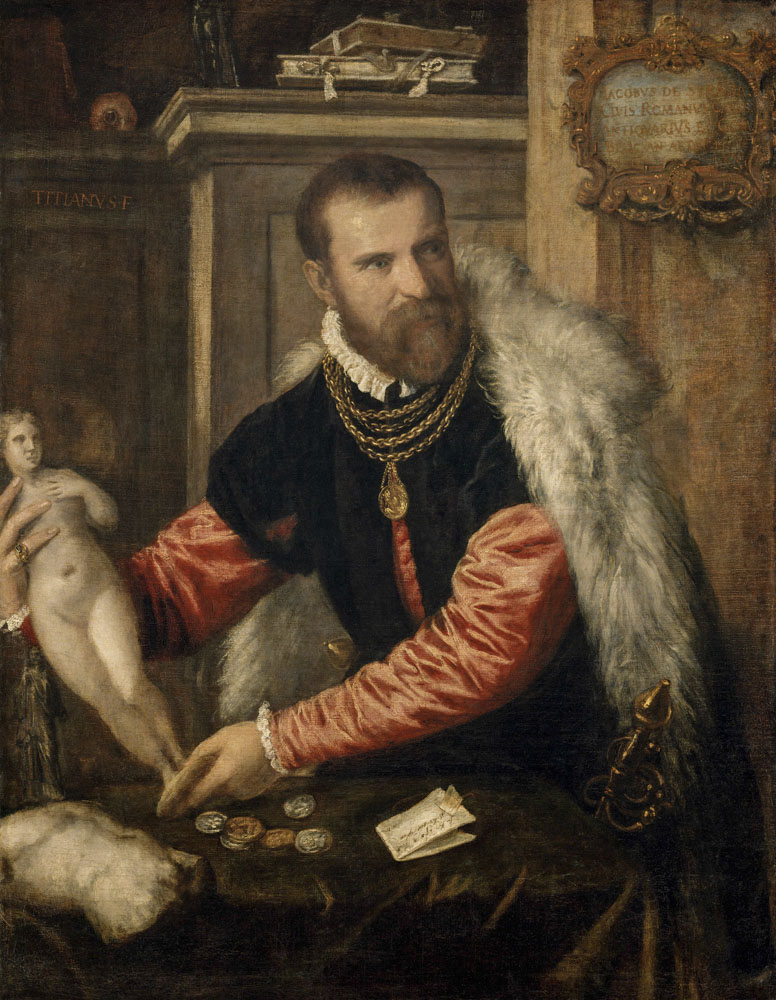
By the 1540s, Strada
must have had acquired a certain renown as an expert in
antiquities, since from 1544 he worked as antiquarian for Johann
Jakob Fugger (1516‒1575). In 1546, he temporarily settled in
Nuremberg, working as painter and goldsmith. During this period,
he started to collect material for his future numismatic
writings. Fugger sponsored his studies by granting him funds for
his journeys to France and Italy, where he visited coin
collections and exchanged ideas with fellow antiquarians. In
1553, before leaving for Rome to spend two years as Fugger’s
antiquities’ scout, he published in Lyon the only printed book
he ever authored.
This book was the
Epitome Thesauri Antiquitatum, hoc
est Impp. Rom. Orientalium et
Occidentalium Iconum, ex antiquis Numismatibus quàm fidelißimè
deliniatarum. Ex Musaeo Iacobi de
Strada Mantuani Antiquarij (Epitome)
(fig. 2)[5].
The Epitome is a book of biographies enriched with
portraits of the Roman emperors from Julius Caesar to Charles V,
including their relatives (fig. 3)[6].
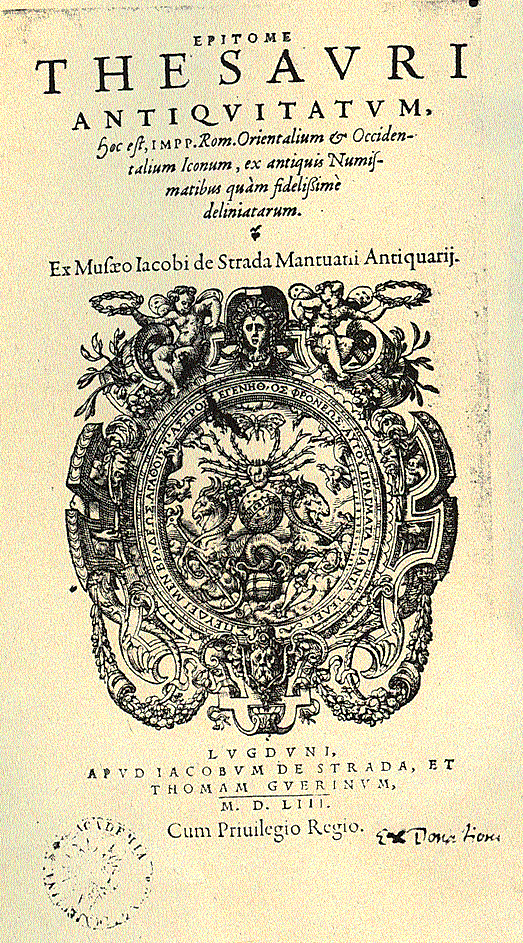
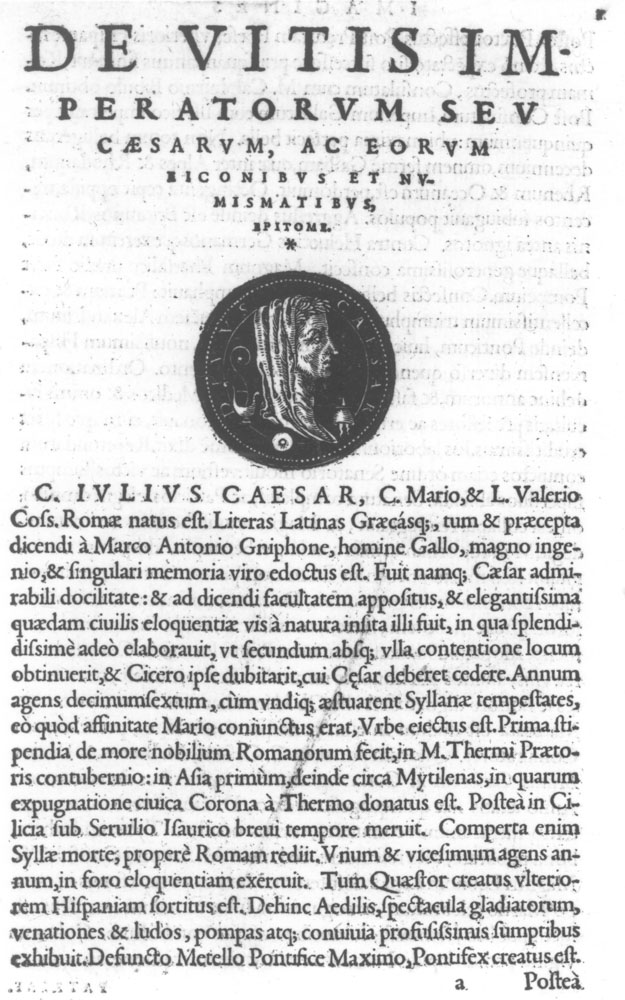
In addition, the
Epitome contains short descriptions of several coin reverses[7].
These reverses remained without illustrations, since the
conversion into woodcuts would have required a considerable
amount of time and technical effort[8].
Strada took many of these reverse motifs[9]
from the illustrations of his MAGNUM AC NOVUM OPUS Continens
descriptionem Vitae imaginum, numismatum omnium tam Orientalium
quam Occidentalium Imperatorum ac Tyrannorum, cum collegis
coniugibus liberisque suis, usque ad Carolu(m) V. Imperatorem.
A Iacobo de Strada Mantuano
elaboratum. TOMUS PRIMUS. ANNO DOMINI MDL
(MaNO) (fig. 4)[10].
This thirty-volume work is the
subject of our research project at the Forschungszentrum Gotha[11].
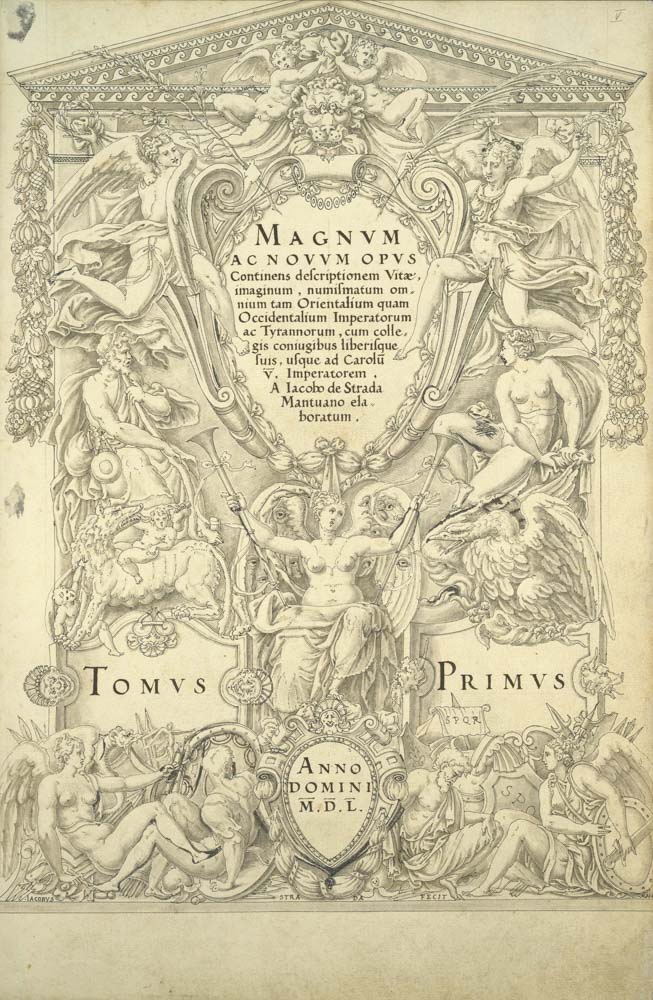
The descriptions in the
Epitome are so precise that the coins and contorniates
mentioned can be identified[12].
Strada was the first to publish descriptions of coin reverses
and thus made a considerable contribution to sixteenth-century
numismatic research[13].
In addition, his comments provide information on many aspects of
numismatics and antiquarian research: i.e. religion, ceremonies,
architecture and Roman society. Strada’s research on ancient
monuments was based on the concept of the division of
antiquitates into sacrae, publicae,
privatae and militares as established by Marcus
Terentius Varro[14].
In the preface of the Epitome he wrote about the
importance of in-depth knowledge of the coins to be able to
distinguish genuine exemplars from contemporary
imitations/fantasies[15].
He said that, in his days, coins existed that were made by
»engravers who are as brilliant as they are excellent, [so] that
they are comparable to the ancients, and who are too well-known
to be named here. Therefore, one must take the greatest care to
select the coins which have just been made in bas-relief by the
[masters] who are particularly experienced, for their beauty and
elegance«[16].
The names of these engravers can be found
in Enea Vico’s Discorsi sopra le medaglie[17]:
Giovanni da Cavino and his son; Vettore Gambello, Benvenuto
Cellini, Alessandro Cesati called Greco, Leone Leoni from
Arezzo, Iacopo da Trezzo and Federico Bonzagna from Parma.
At the time, Federico Bonzagna was
considered the most talented of these modern engravers[18].
Nonetheless, as will be
shown below, even Strada did not always succeed in
distinguishing modern creations from original ancient coins. He
was also not averse to inventing coin motifs that he then
included in his numismatic works. Here, I present three examples
of illustrations from volumes 1 to 14 of the MaNO[19].
Strada’s Creative
Numismatics
The first example is a
rather visually expressive coin, depicting the murder of Cicero.
It is described in the Epitome, in which only its obverse
is illustrated (fig. 5). Obverse and reverse are shown on a
drawing in the MaNO (figs 6a and b)[20]
and described in the A<ureorum> A<rgenteorum> A<ereorum>
NumismatΩn Antiquorum: ΔΙАΣKEYH. Hoc est, Chaldaeorum,
Arabum, Libycorum, Græcorum, Hetruscorum, ac Macedoniæ, Asiæ,
Syriae, Ægypti, Syculorum, Latinorum, seu Romanorum Regum, a
primordio Vrbis, Deûm, Coss. tempore Reipub: & crescente adhuc,
tam sub Cæss. Latinis, in occidente, quam Græcis Impp. in
oriente, declinante Imperio P.R. denique Hexarchorum, Barbarorum
Principum, Ducumuè: METALLICARUM EICONUM explicatio. Ex Musæo
IACOBI STRADÆ Mantuani Antiquarij, Civis Romani: Cum septem
Indicibus Locupletissimis, partim Alphabeticis, quibus res
diuersissimæ continentur, partim serierum, quæ Regum, Cæss.
Impp. ac Tyrannorum, necnon Heroinarum nomina perscribunt
(Diaskeué) (fig. 7)[21].
This eleven-volume manuscript of coin descriptions is a further
subject of our research project. Strada states in the
Diaskeué that he saw this bronze coin at Giulio Romano's
house in Mantua[22],
while in the Epitome he mentions Rome as the coin’s home[23],
Unfortunately, no original coin model could be determined for
the two drawings[24].
Strada used here a literary source as
basis for the coin drawing, i. e. a
reference to Livy. He described the proscriptions under the
triumvirate of Octavian, Lepidus and Antonius, the aim of which
it was to avenge Caesar, and named the most famous victims[25].
Their portraits are depicted on the obverse of the coin. The
reverse of an aureus minted for Septimius Severus might have
been used as model (figs 8a and b). There, Julia Domna is
depicted between Caracalla and Geta[26].
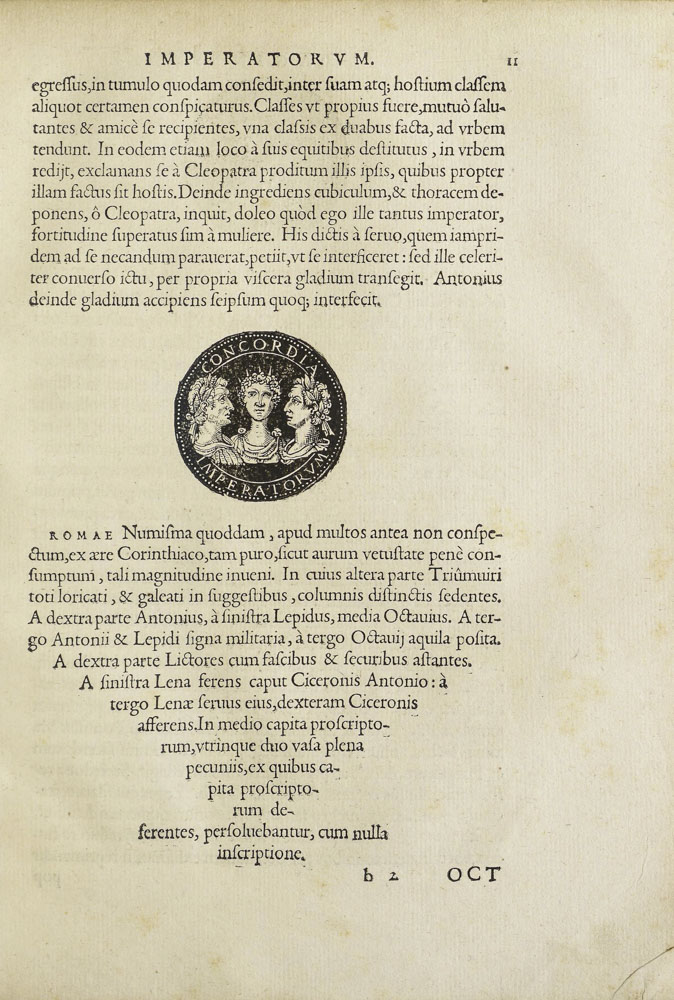
Fig. 5: Coin with the triumviri, Epitome, p. 11 (HAB Wolfenbüttel)
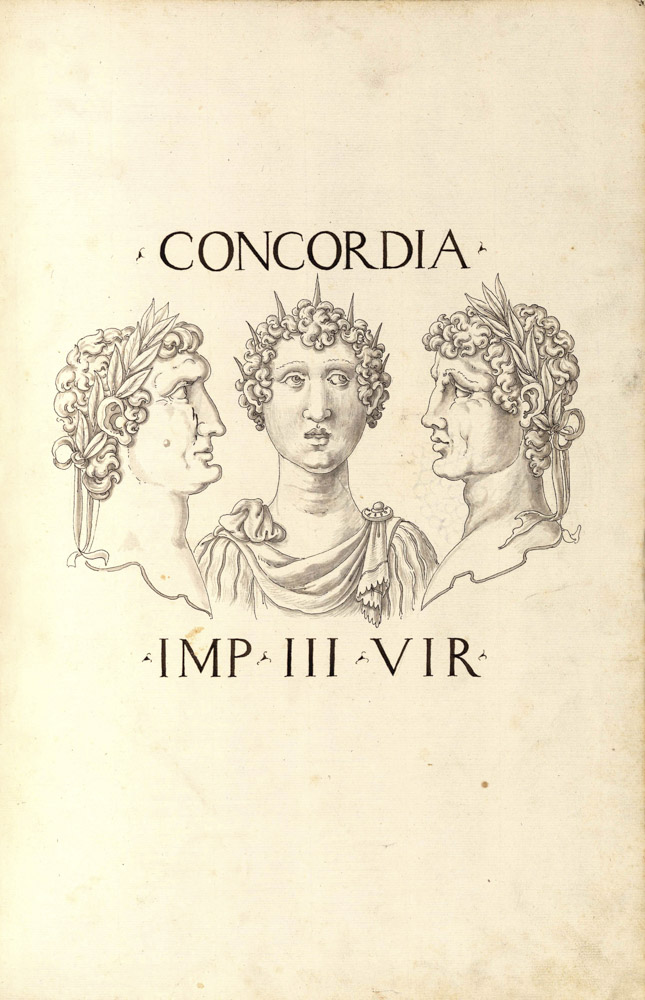
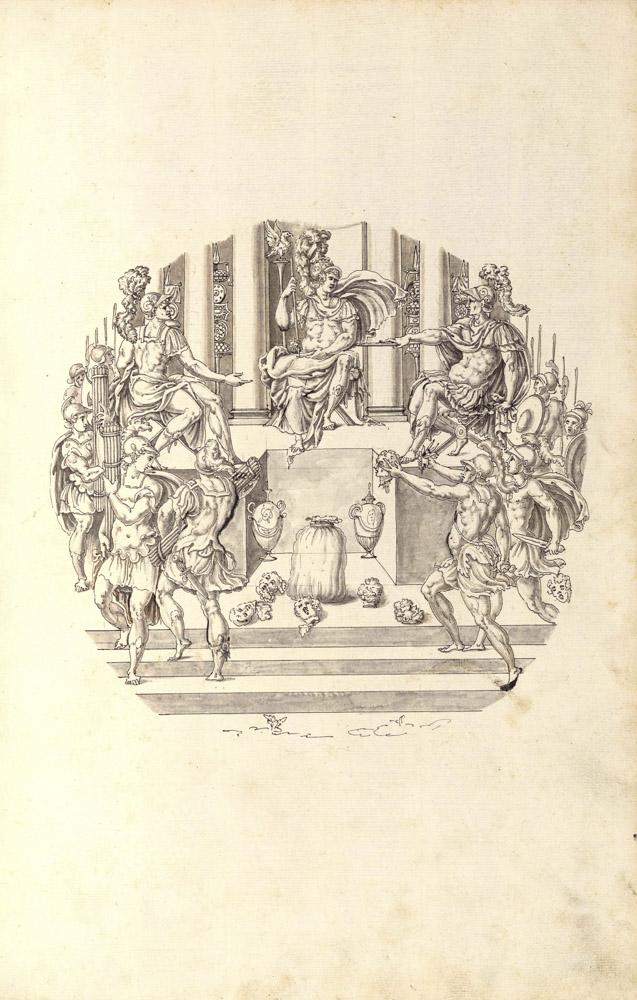
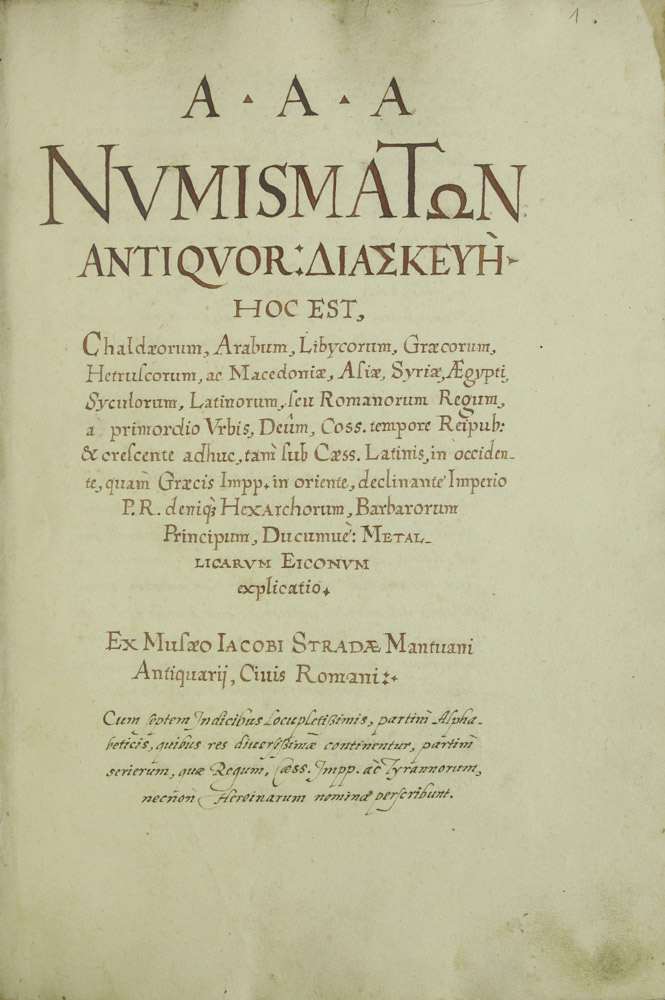
Fig. 7: Frontispiece of the Diaskeué 1 (UB Wien)
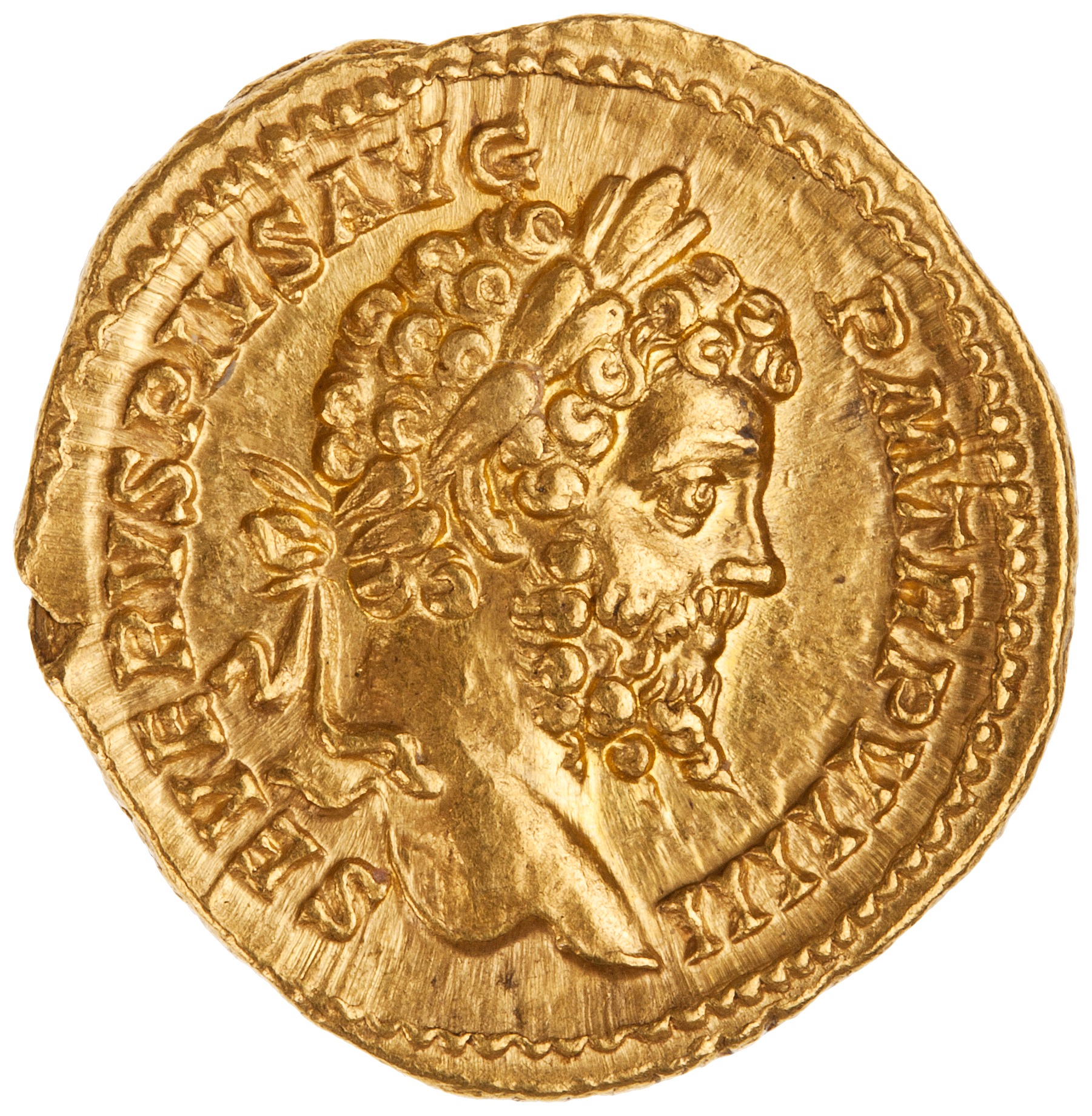
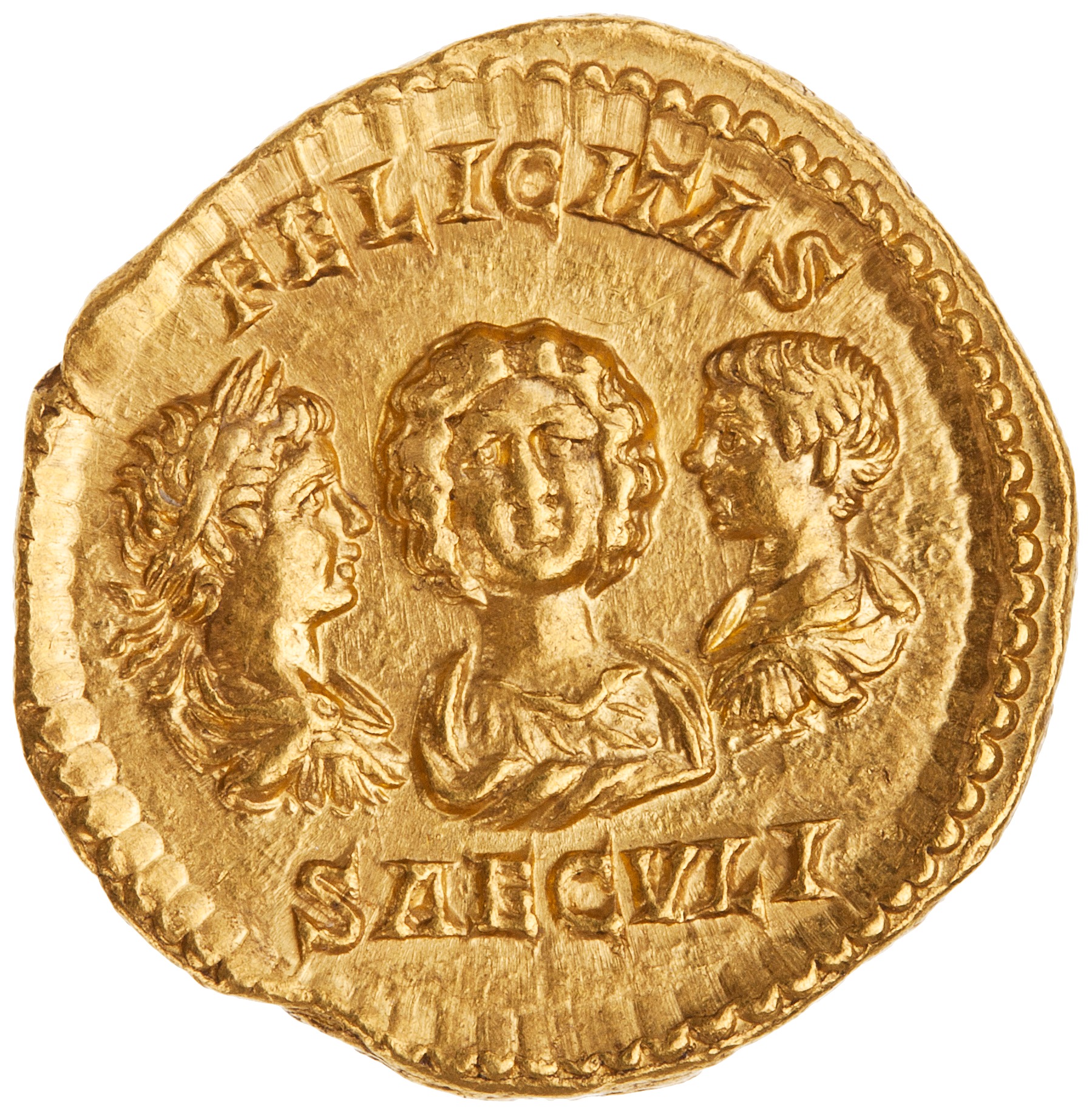
Sometimes it is assumed
that this dramatic scene (fig. 9) was based on models used in
the paintings of the great decorative programmes of the time.
Nonetheless, no corresponding models could be identified in the
work of Giulio Romano[27]
or in Rome[28].
Only for some individual motifs potential models could be
discerned, as happened, for example, for the presentation of
Cicero’s head by the legionary Laena. Such scenes exist on the
Column of Trajan[29],
of which Strada probably made a copy (fig. 10)[30].
The trial scene, composed like a stage set, might instead have
been modelled on miniature drawings by Giorgio Giulio Clovio
(1498‒1578)[31],
for example on the book illuminations entitled The Conversion
of Proconsul Sergius (fig. 11) and Faith, Love, Hope
(fig. 12). Since none of Strada’s contemporaries illustrated
this coin, i.e. neither Enea Vico, Hubertus Goltzius, Sebastiano
Erizzo nor Pirro Ligorio, it is safe to assume that it was
Strada’s own invention.
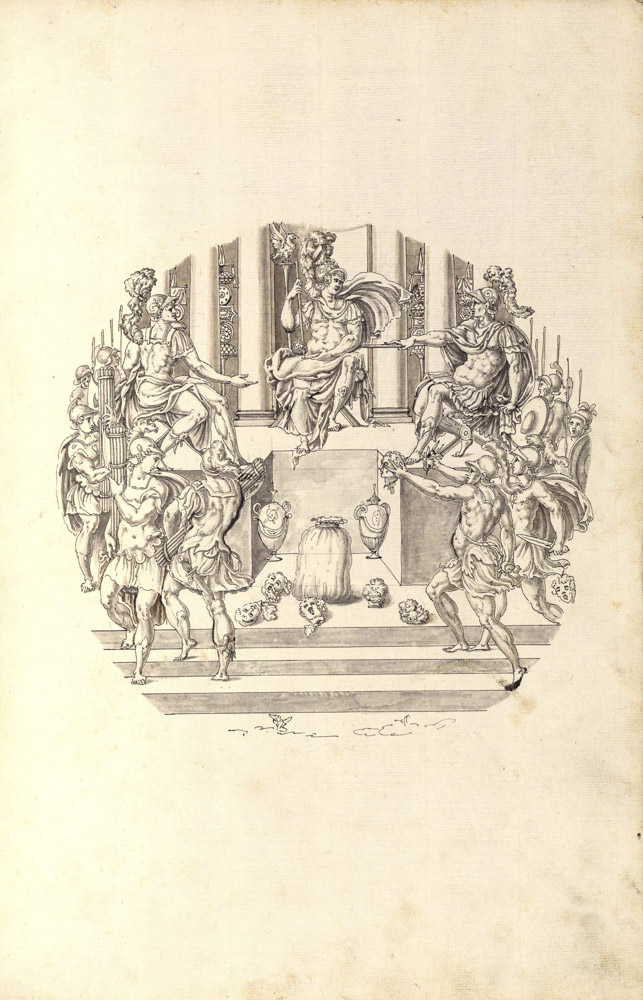
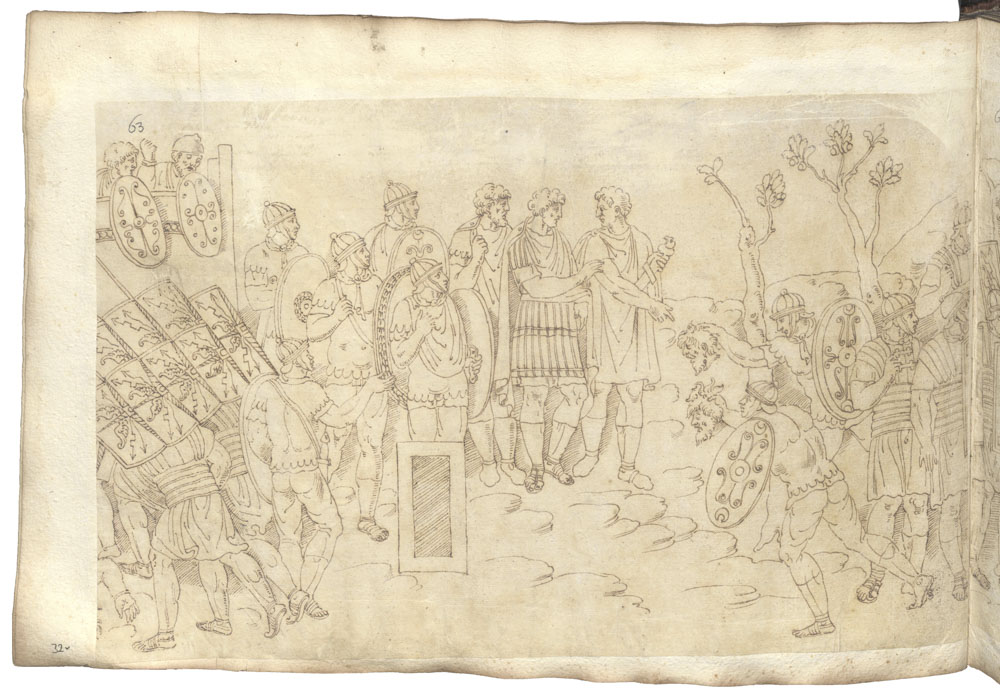
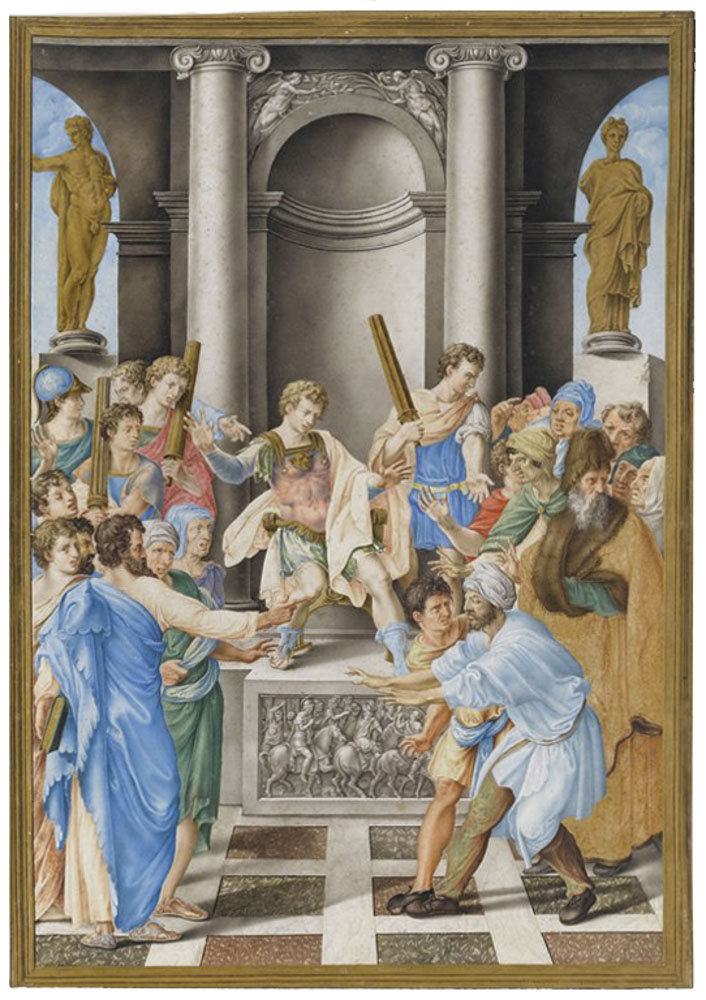
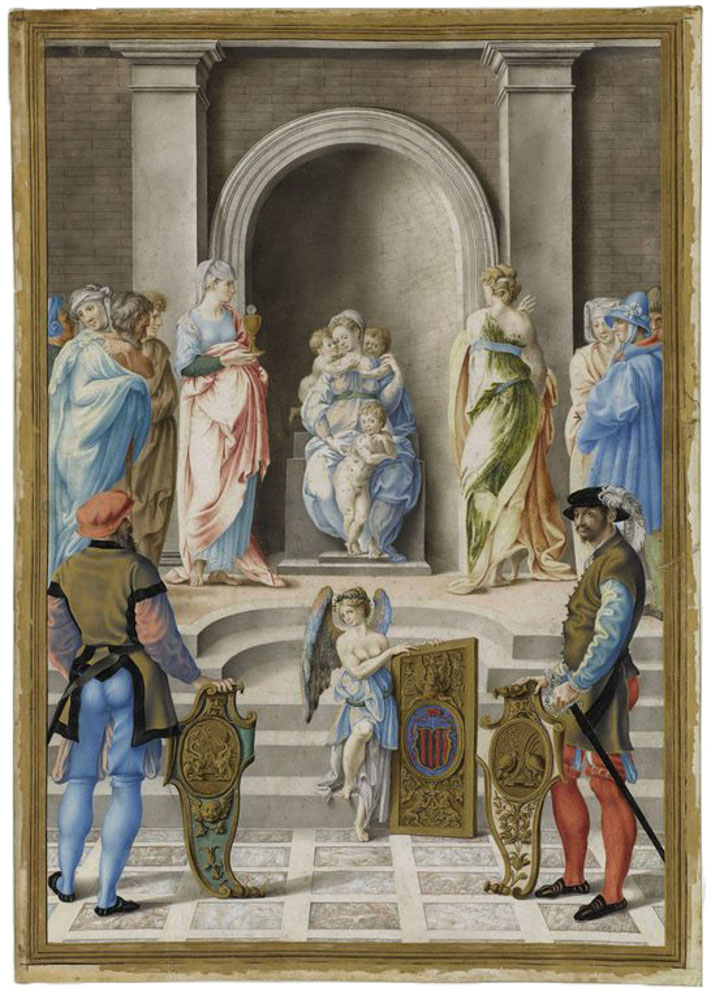
Another one of Strada’s
very creative and peculiar inventions is a ship with a prora
in the shape of an elephant’s head (figs 13a and b)[32].
It can be found in the third volume of the MaNO which is
dedicated to the coins of Marcus Antonius. Unfortunately, there
is no description in the Diaskeué nor could an exact
ancient model be identified[33].
What led Strada to this invention – perhaps meant as an allusion
to Cleopatra and the lost Egyptian fleet[34]
or simply the misinterpretation of a coin image – must remain
without answer.

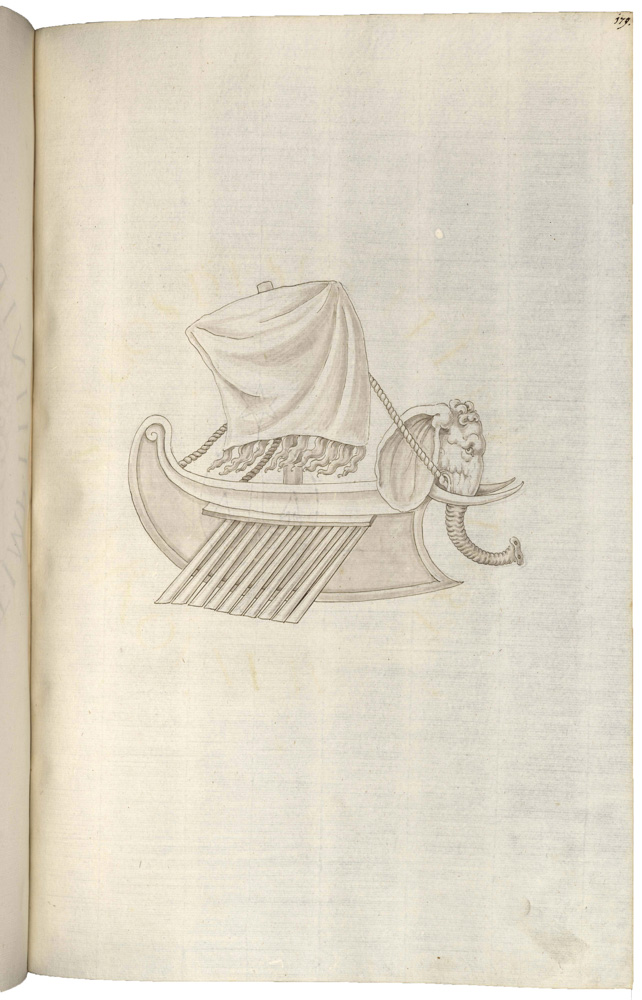
The third coin offers
Strada’s most interesting invention, accepted until the
nineteenth century. It is a denarius with Augustus radiate but
no legend on the obverse. On the reverse (fig. 14), the temple
of Janus Quadrifrons is shown with the inscription PAX ORBIS
TERRARVM IMP. PERPET. S. C. This coin is said to have been in
Strada’s own coin collection.
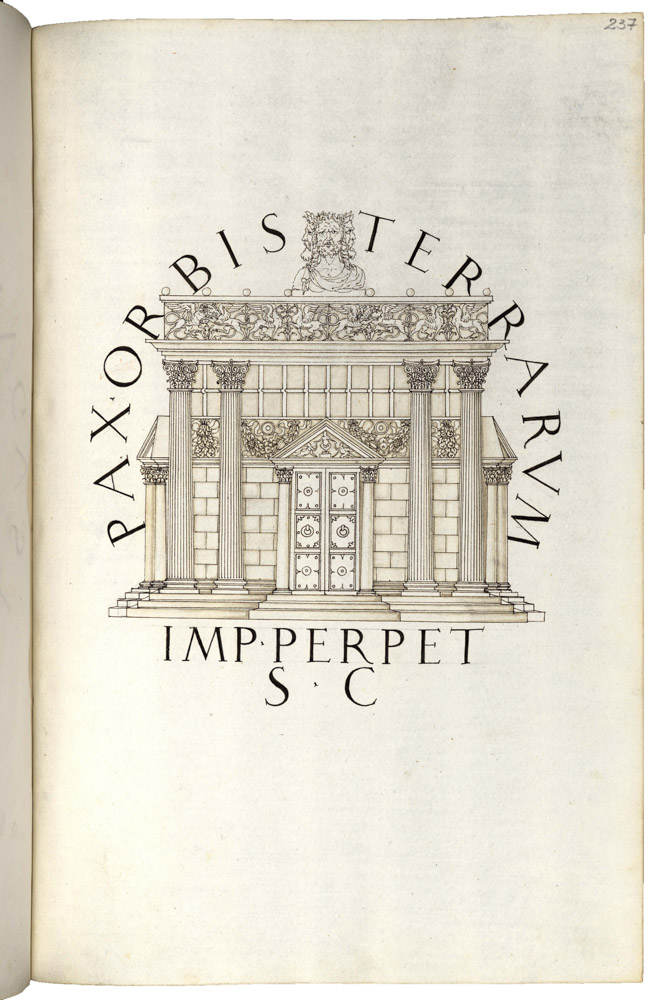
No such ancient coin
ever existed. The model for this invention was probably a
sesterce of Hadrian, also depicted by Du Choul in his work
Discours della religion des ancien Romains, on which Janus
is depicted with three faces (fig. 15)[35],
although normally he is only shown with two. For the temple
building, Strada borrowed parts of the illustration of the
Temple of Janus on coins of Nero which he also depicted in the
MaNO (fig. 16)[36],
e.g. the gate of the temple and the construction of the roof.
Furthermore, the coin legend itself is an invention. It actually
either refers to Christ or to an ideal Christian ruler[37],
since for the motif on the coin obverse – showing Augustus
radiate, and therefore deified, as described in the Diaskeué
– a ›divus‹ legend would normally be expected[38].
Du Choul was Strada’s only contemporary who illustrated this
representation of the temple (fig. 17)[39]
which, as he states, he had received from Strada (see
fig.
15). Du Choul's work was later adopted by
Louis XIV’s and Napoleon I’s coin engravers to commemorate
successful peace treaties, i.e. the Peace of
Rastatt in 1714 (figs 18a and b)[40]
and the Peace of Pressburg (today Bratislava) of 1805 (figs 19a
and b)[41].
When the peace treaty of Pressburg,
negotiated by Francis I of Austria, was broken in 1809 and the
French army remained victorious, Napoleon issued a coin with the
motif of the Janus Temple. In this case, the temple was not
shown with open doors, as had been customary in ancient Rome in
times of war, but with broken doors (figs 20a and b) meant to
indicate a particularly violent breach of peace[42].
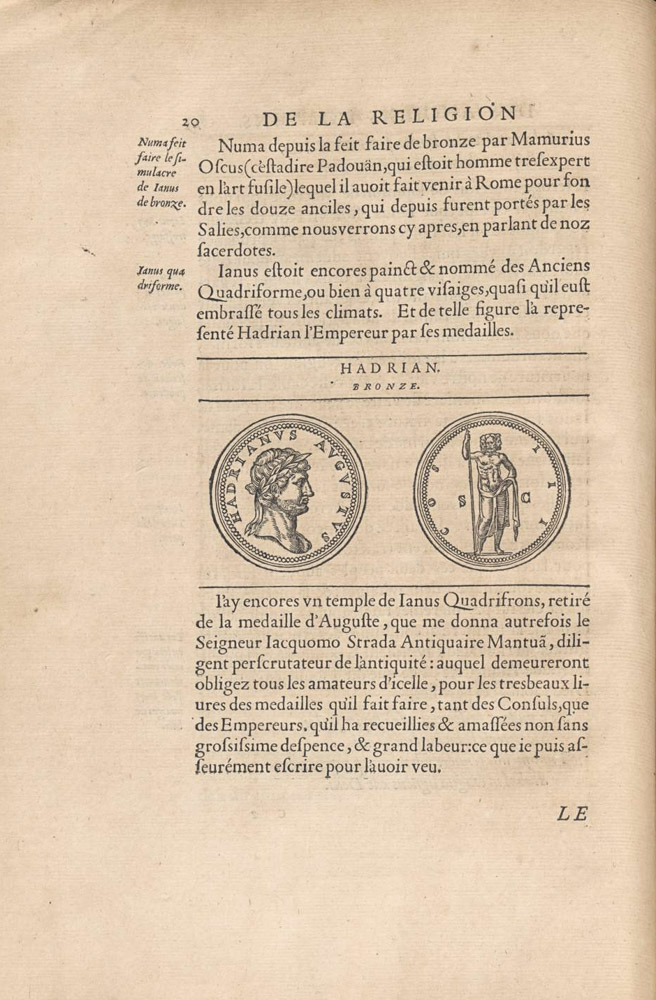
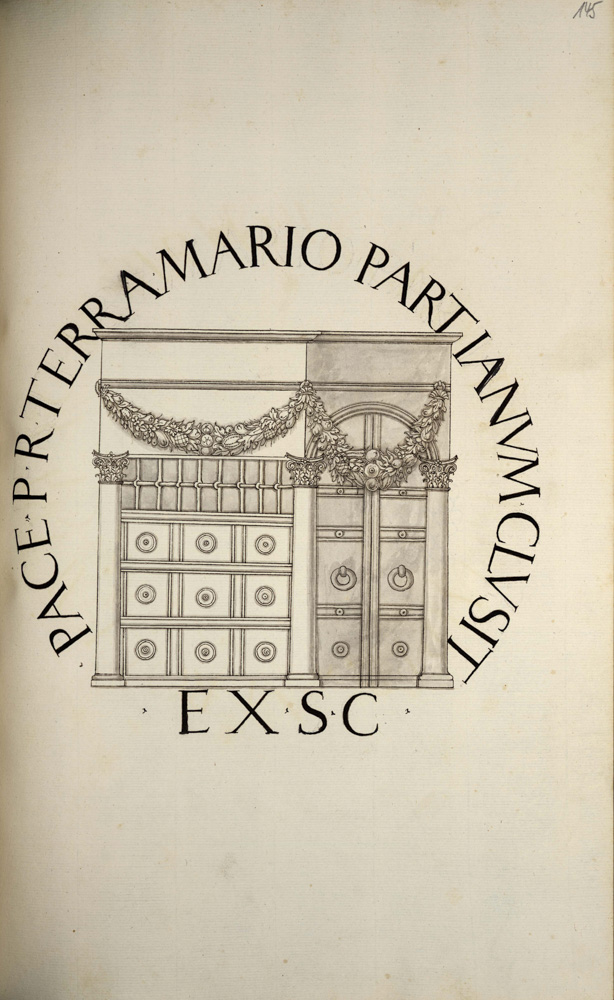
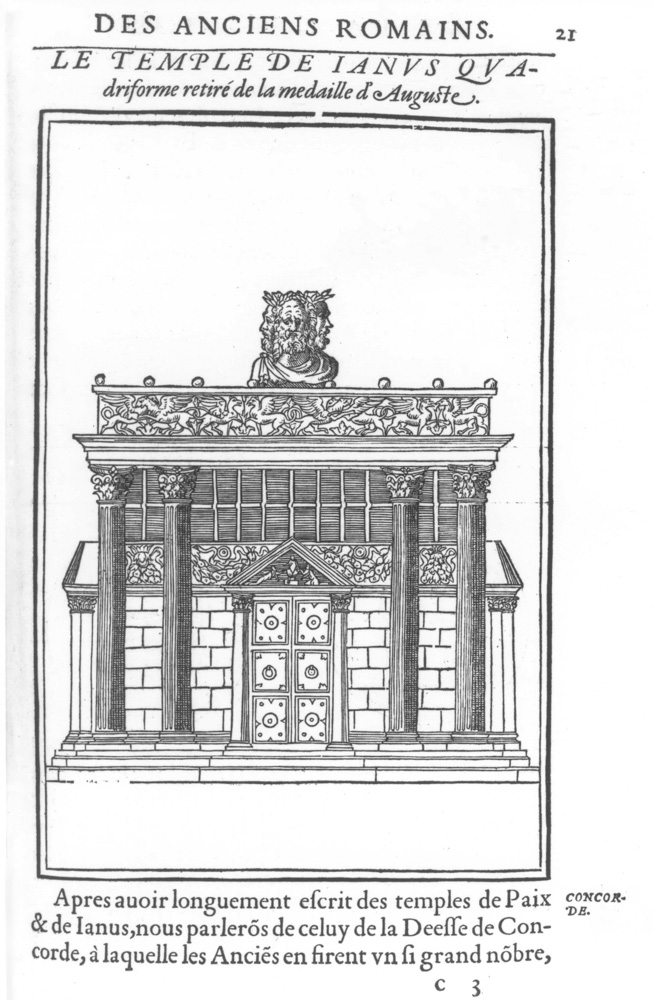
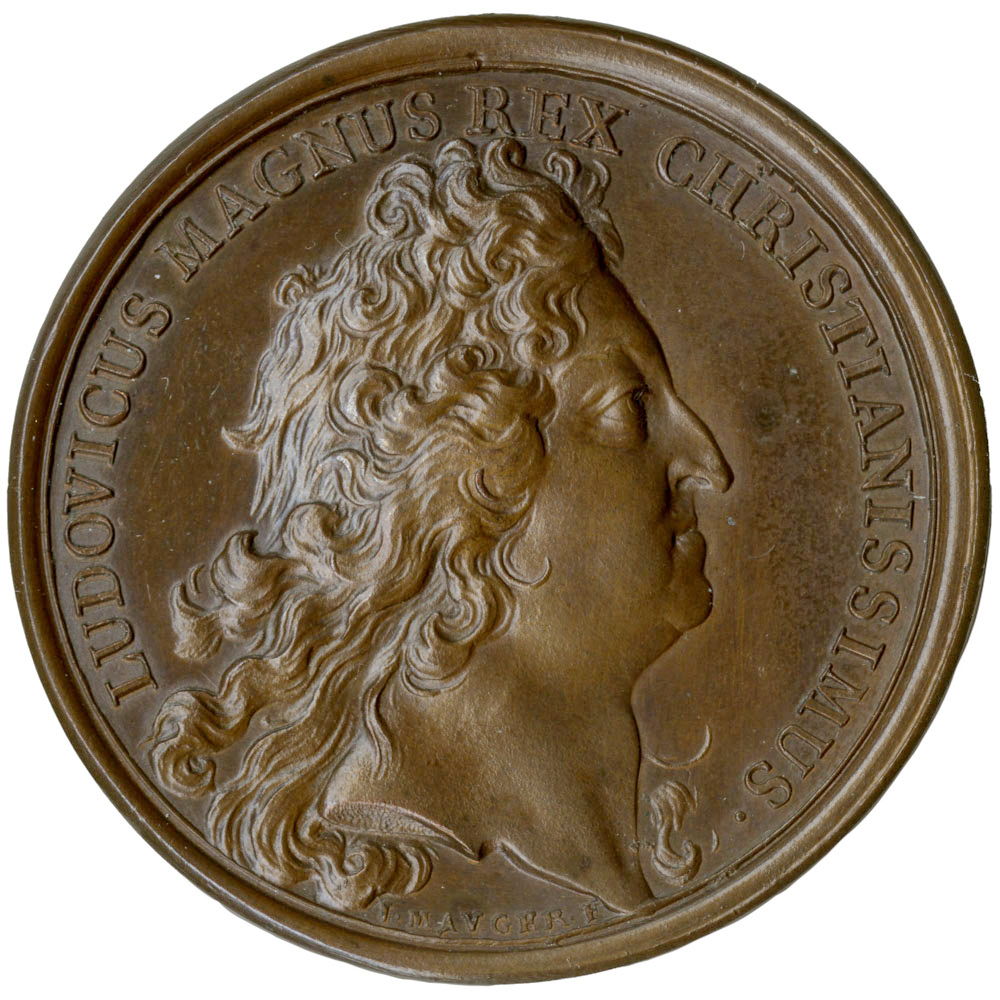
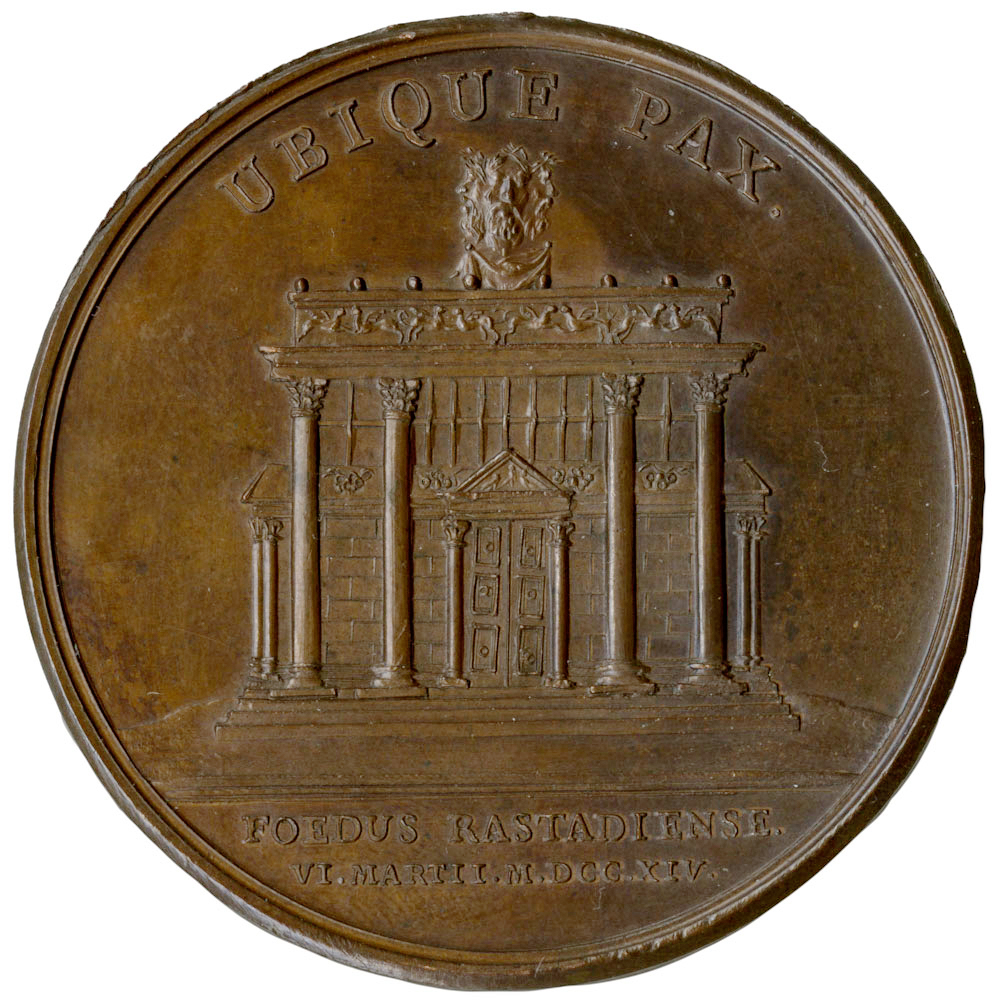
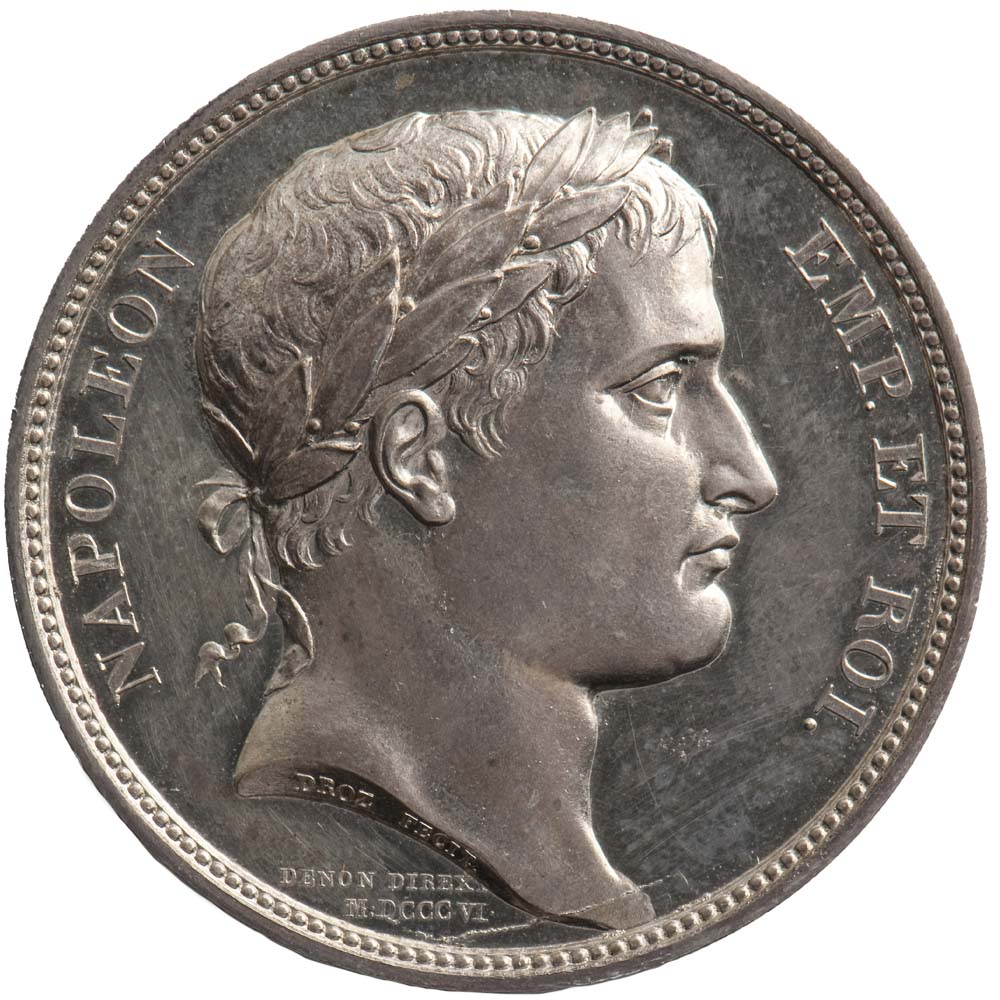
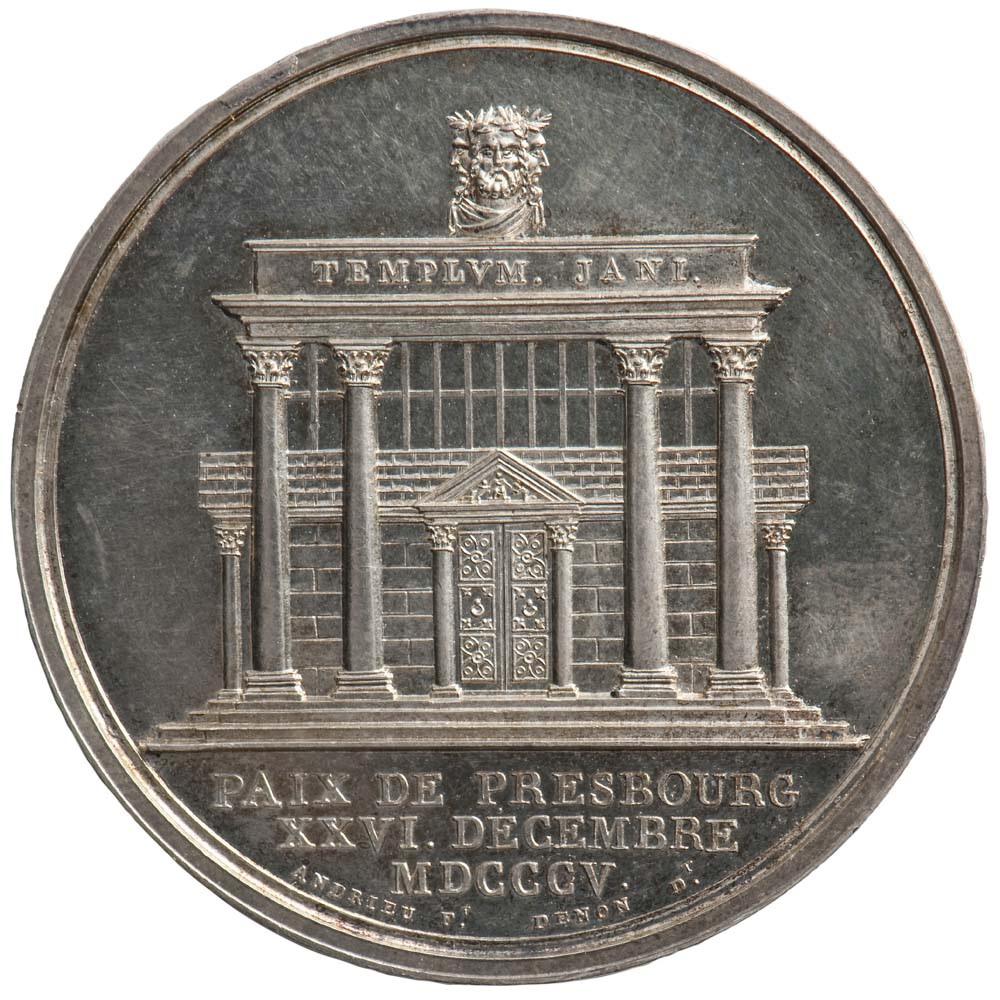
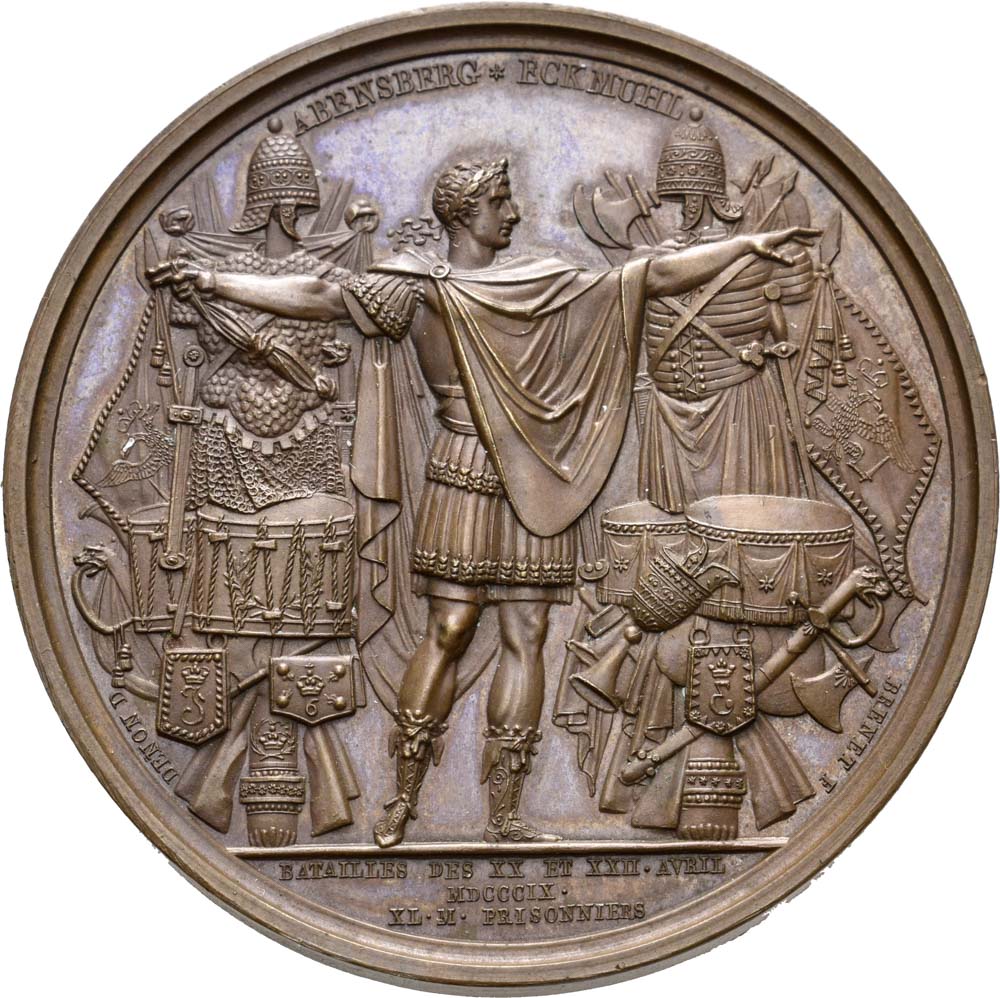
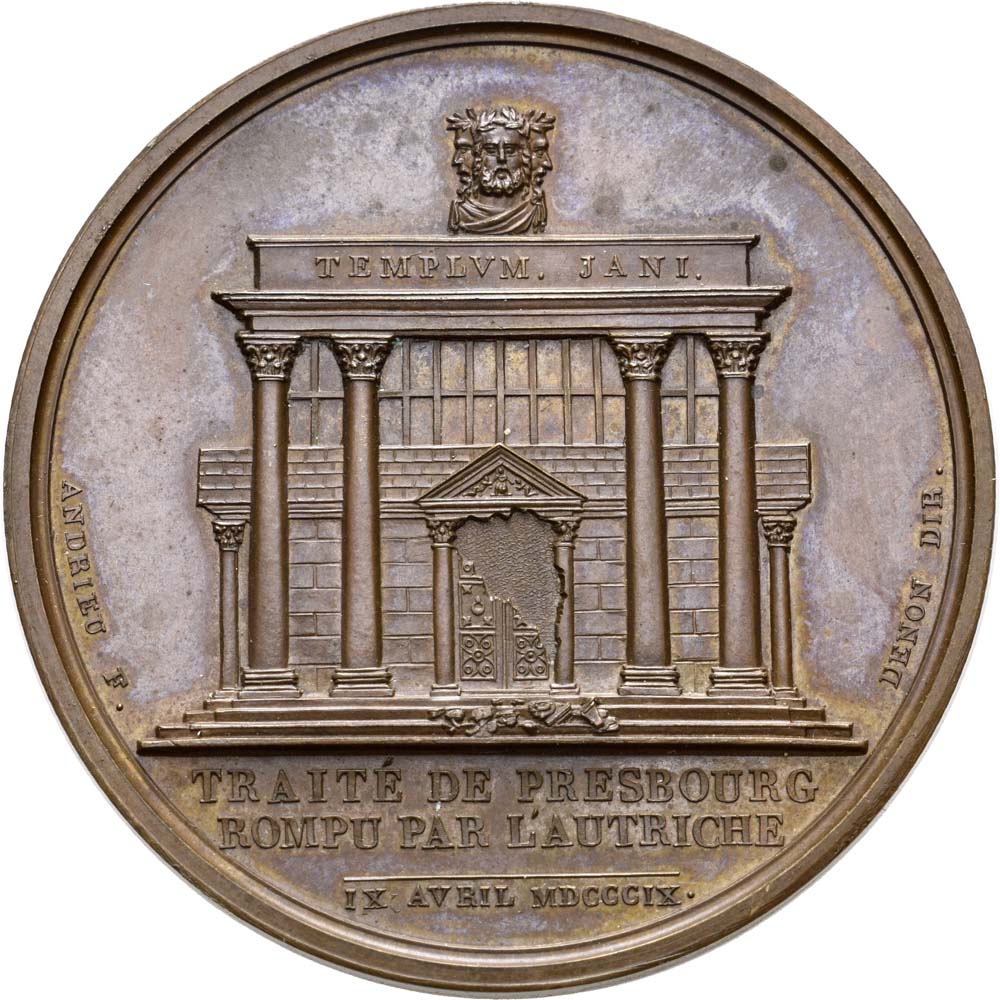
In particular, the third
example shows how much iconographic and numismatic knowledge
Strada was able to use for his inventions. Therefore, he managed
to design details that could not be found on ancient originals
in such a way that they seemed authentic to his contemporaries
(e.g. Du Choul).
Therefore, in the
following section, selected exemplars of coin drawings from the
first 14 volumes of Strada’s MaNO will be presented.
These drawings were based on inventions by contemporary
engravers who also used their talents to design coins after the
antique that owed more to their imagination than to ancient
originals.
Creations by Cavino and
his Contemporaries
To identify Cavino’s and
his contemporaries’ inventions solely by the use of
drawings is very difficult. There only remains an identification
based on inaccuracies in their presentation or on mistakes in
the coin legends. An identification becomes impossible, if the
model for the copy is an authentic coin and if the copy matches
it. In this case, only the careful study of its condition, of
the material and of the edges makes it possible to recognise
whether it is a Paduan.
Inventions without
direct ancient models can be found in the first volume of the
MaNO, for example in the case of »Caesar on the Elephant
Quadriga« (figs 21a and b)[43].
Strada claimed to have seen this coin in the collection of
Antonio Agustín[44].
This claim can however not be confirmed, since Agustín’s
collection was looted and dispersed by Napoleonic troops in the
early nineteenth century[45].
There is no matching illustration in his Dialoghi intorno
alle medaglie etc. Rather, the coin seems to have been
Cavino’s invention (figs 22a and b) and is not depicted by other
antiquarians[46].
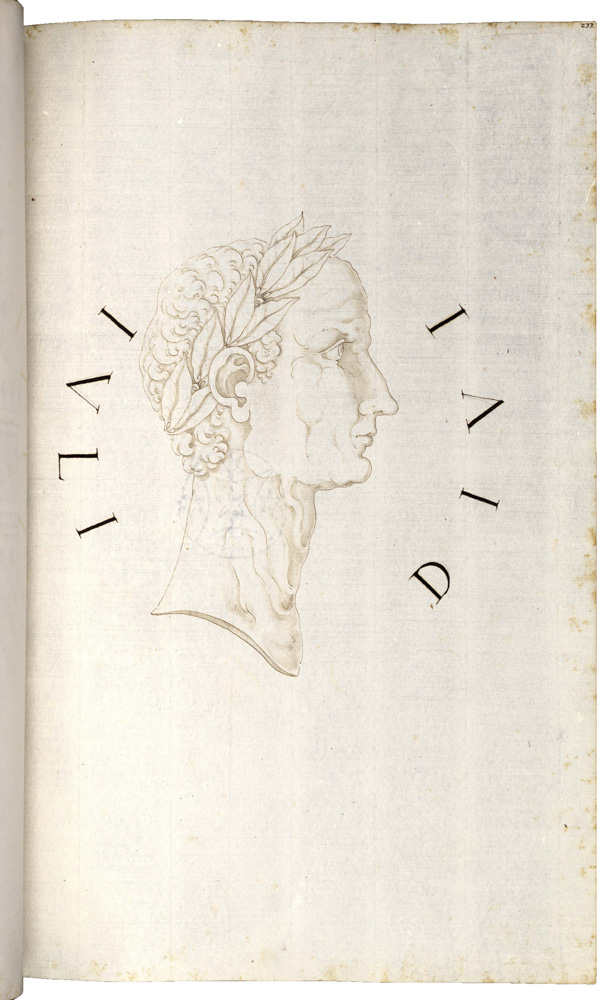
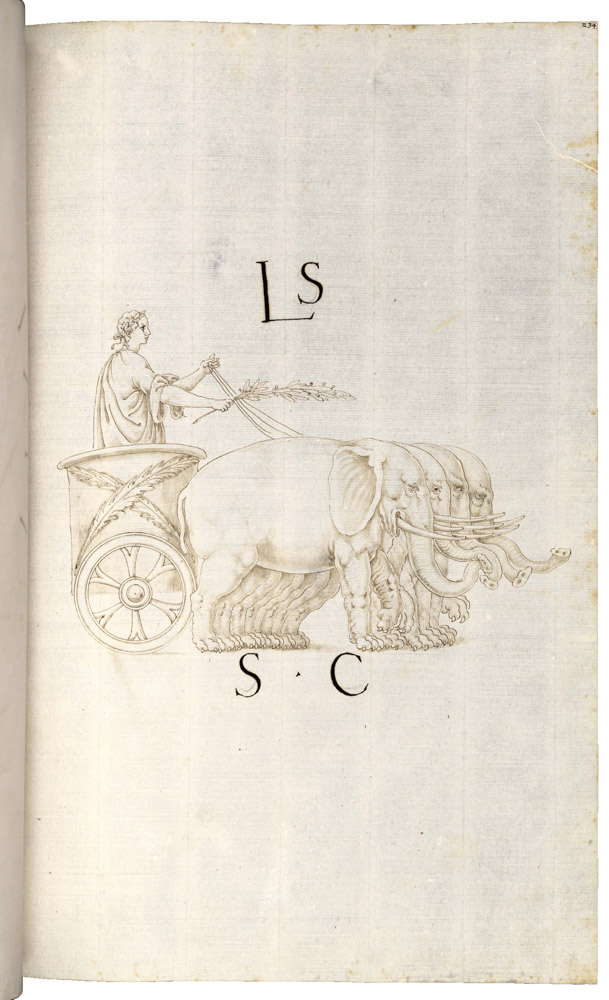
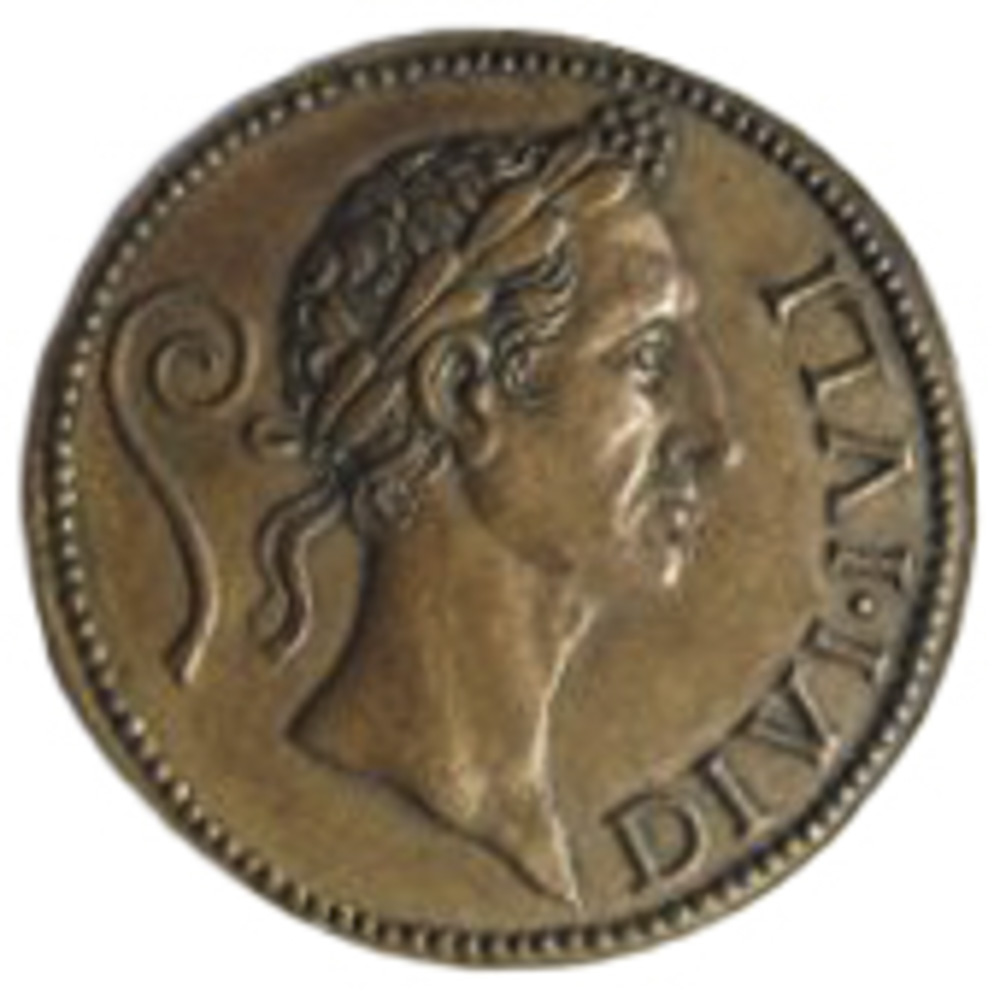
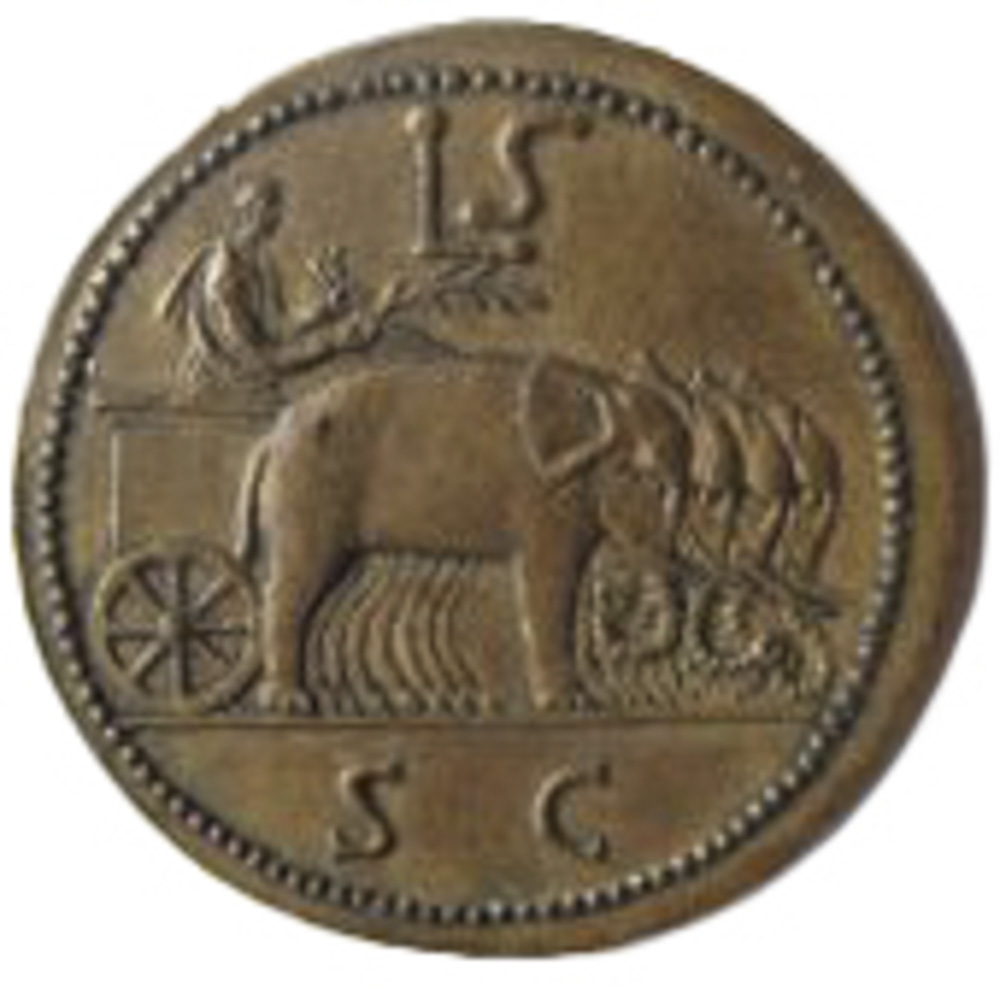
Volume 12 of the MaNO
shows a coin with Titus, laureate and looking to the left, on
the obverse and an Italia with mural crown sitting on a globe on
the reverse (figs 23a and b)[47].
Unfortunately, there is no description in the Diaskeué;
therefore we do not know, in which collection Strada saw this
coin. Its provenance would be of particular interest, since
Klawans assumes that the coin is a modern forgery[48].
While the illustration in the MaNO proves its existence
in the sixteenth century, only Sebastian Erizzo included its
depiction in his Discorso sopra le medaglie antiche etc.
(fig. 24)[49],
in which it is shown with the same reverse legend ITALIA S C.
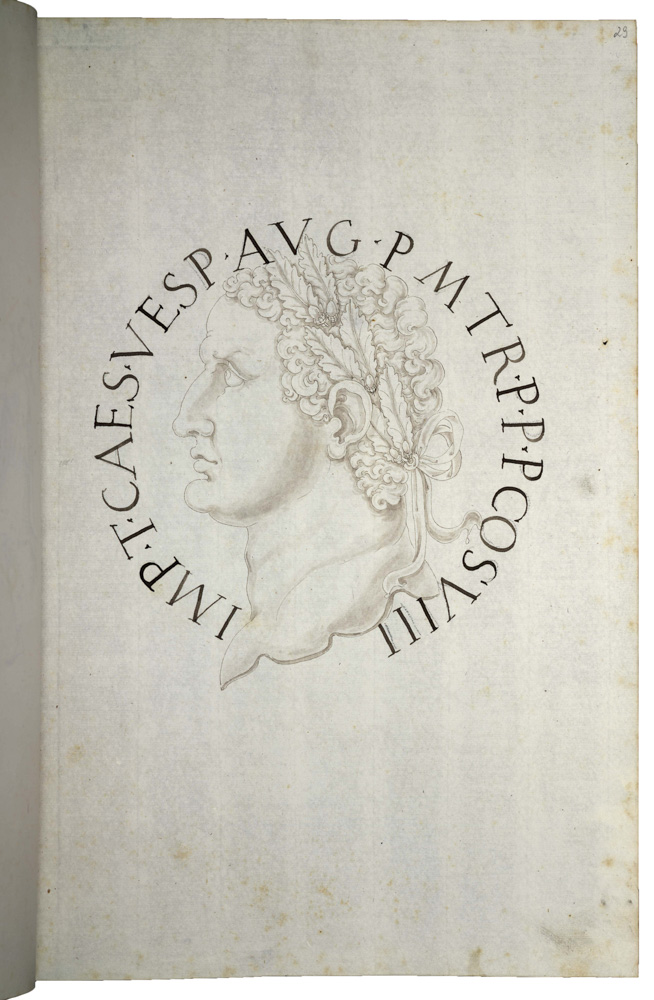
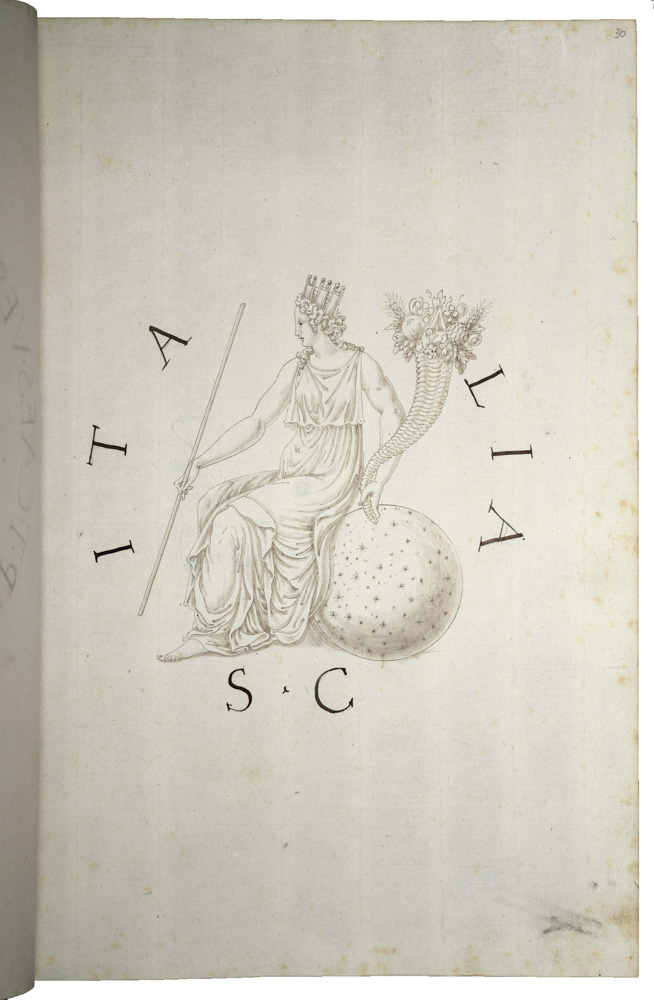
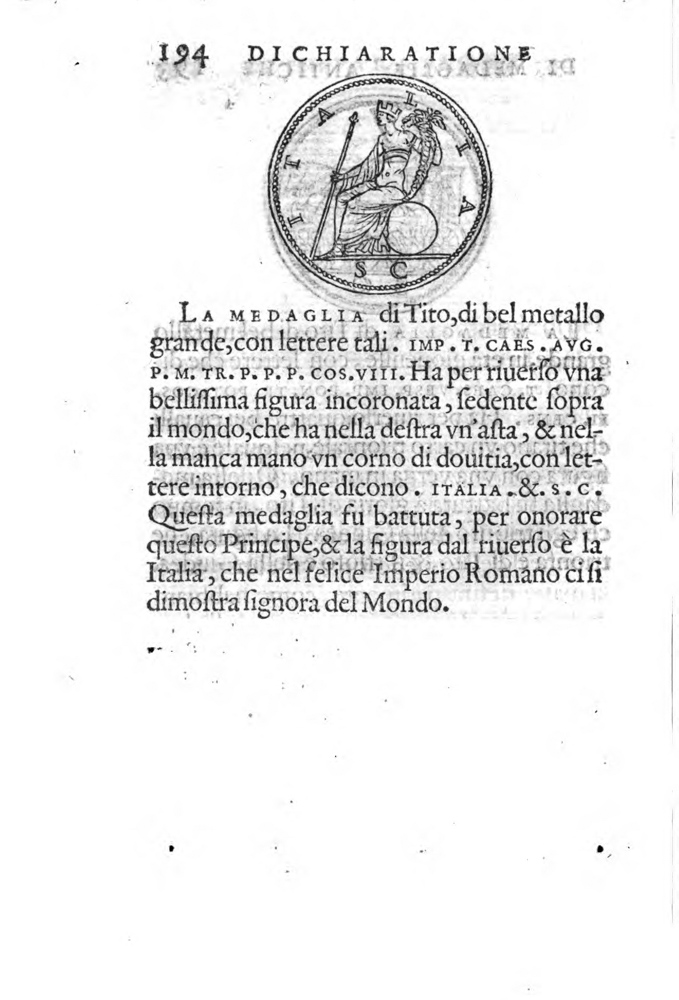
A further invention by
Cavino without any direct ancient model is a coin with Vespasian
on the obverse and the Colosseum and the Meta Sudans on the
reverse (figs 25a and b)[50].
He claimed to have seen it in Fugger’s as well as Agustín’s
collections. Here, Cavino combined the obverses and reverses of
several ancient models (obverse of the sesterce of Vespasian
with the reverse of a sesterce of Domitian for his deified
brother Titus (figs 26a and b)[51].
Strada described Vespasian on the obverse as »looking to the
right« (fig. 27); in the same way he is also shown on the –
probably – original Paduan. There, the legend COS VII
substitutes the inscription of COS VIII included in both drawing
and description. Nonetheless, Strada presented Vespasian as
»looking to the left«, identical to another Paduan based on a
sesterce of Titus (figs 28a and b)[52].
Apart from Strada, no other antiquarian reproduced this coin.
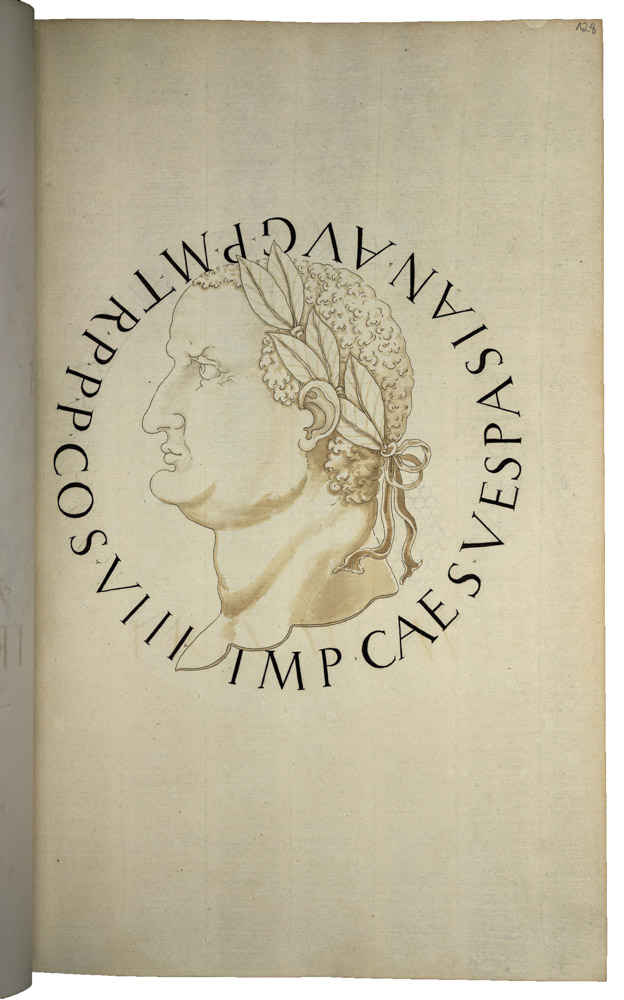
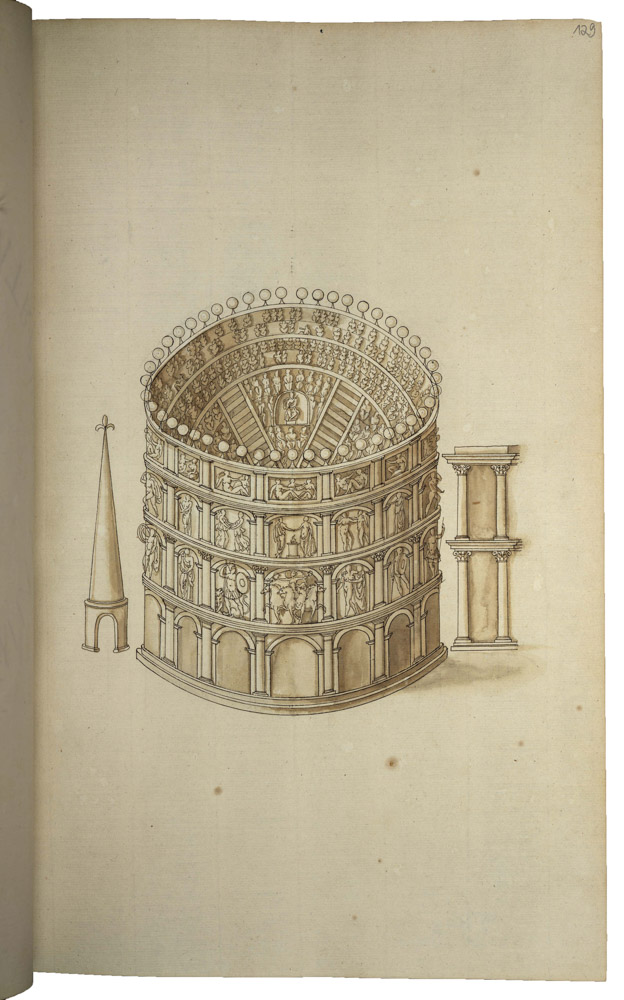
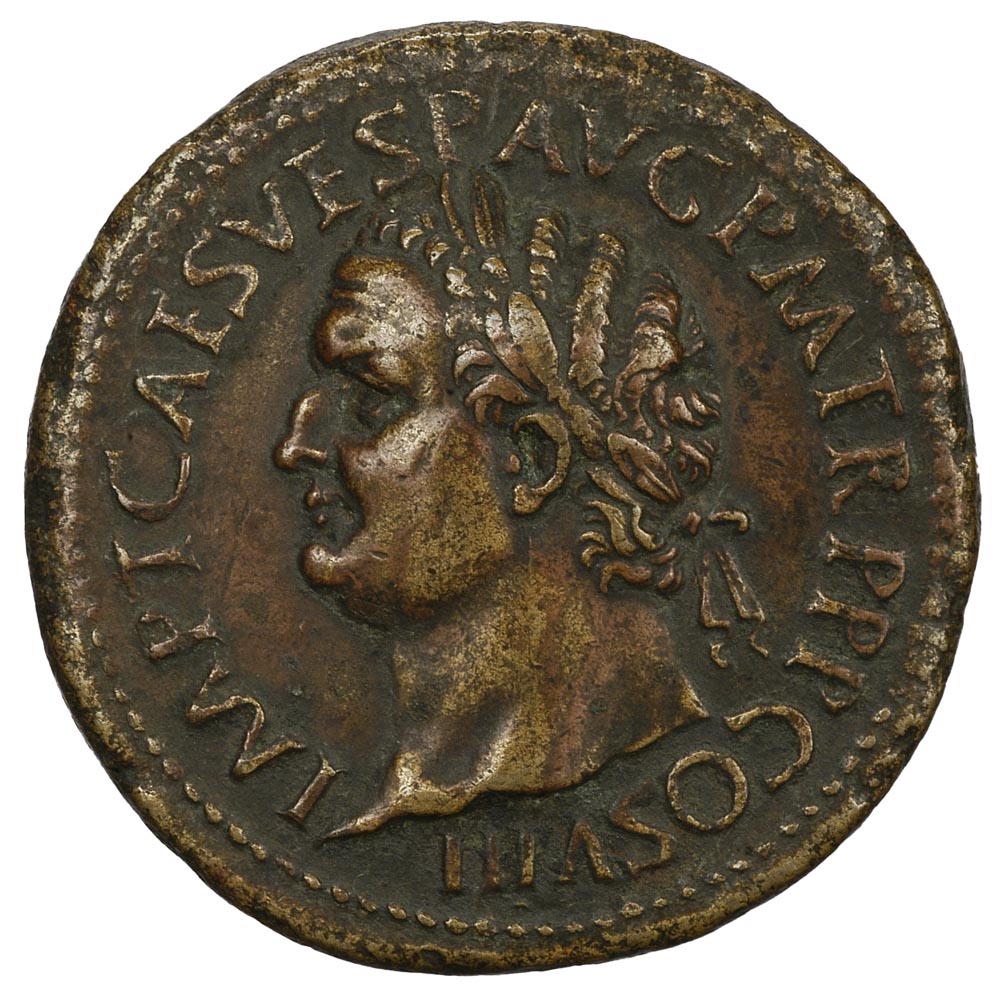
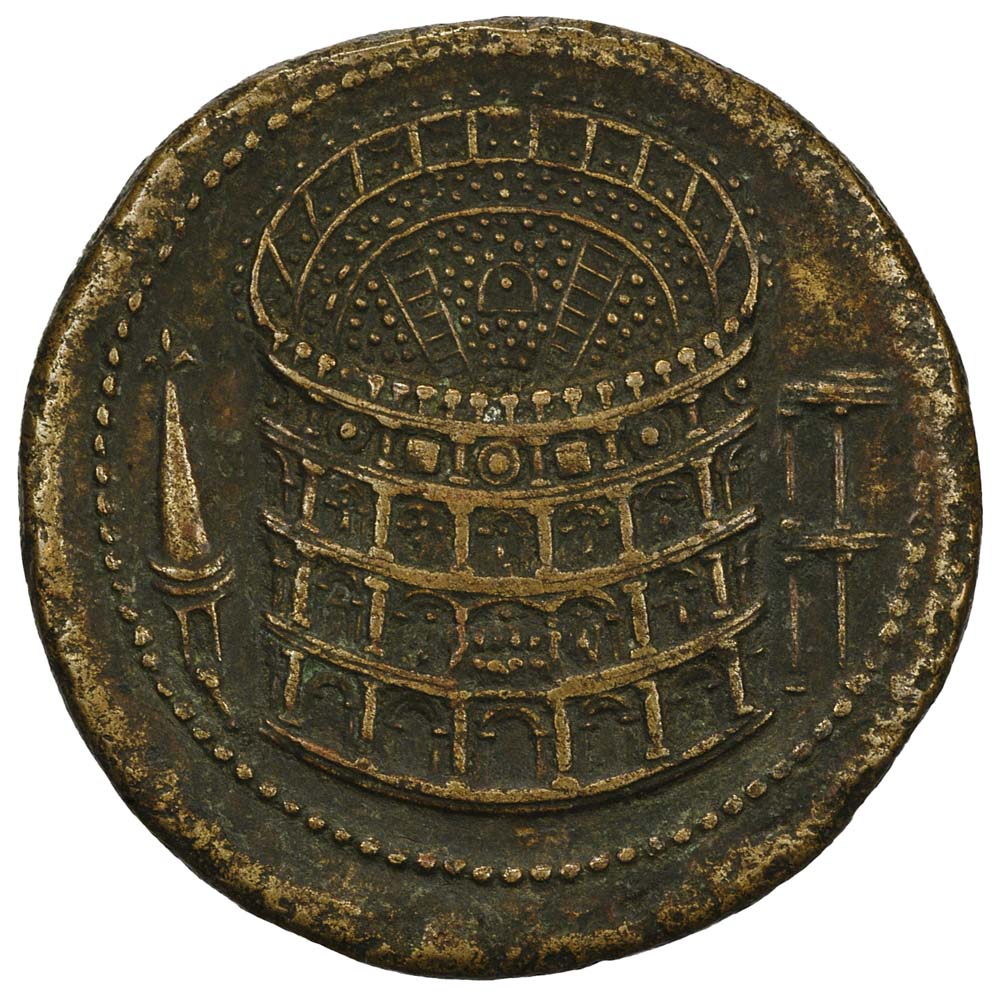
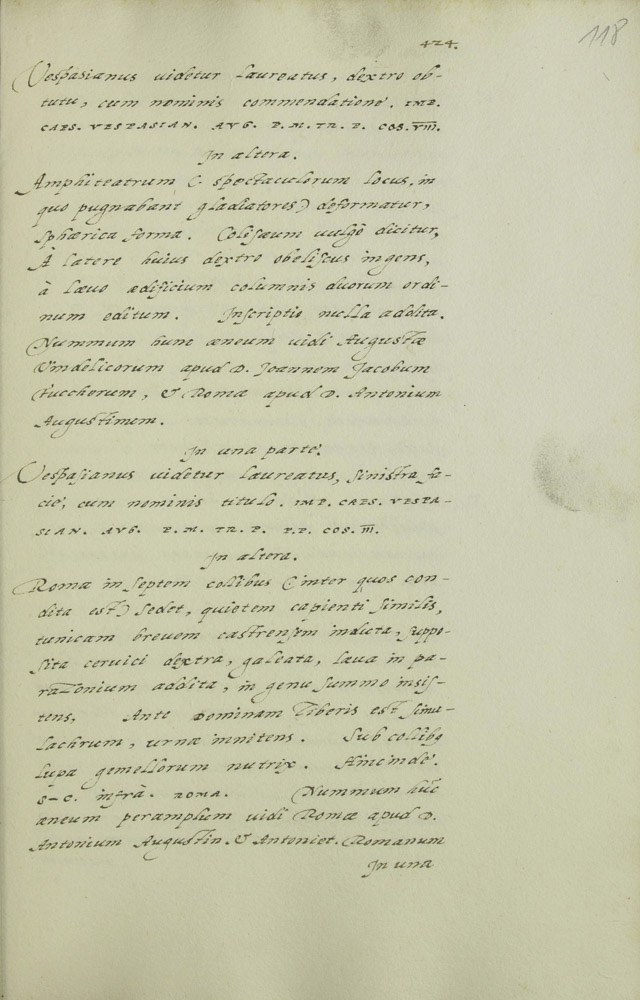
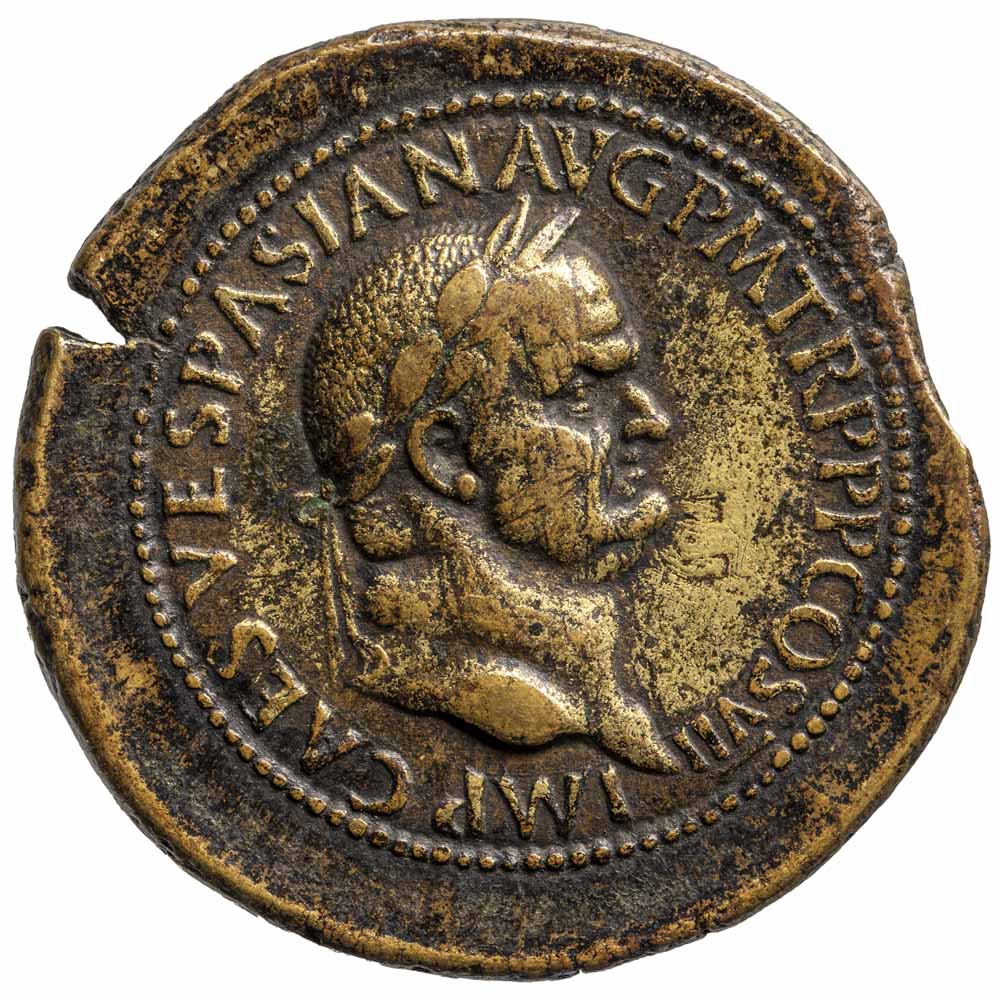
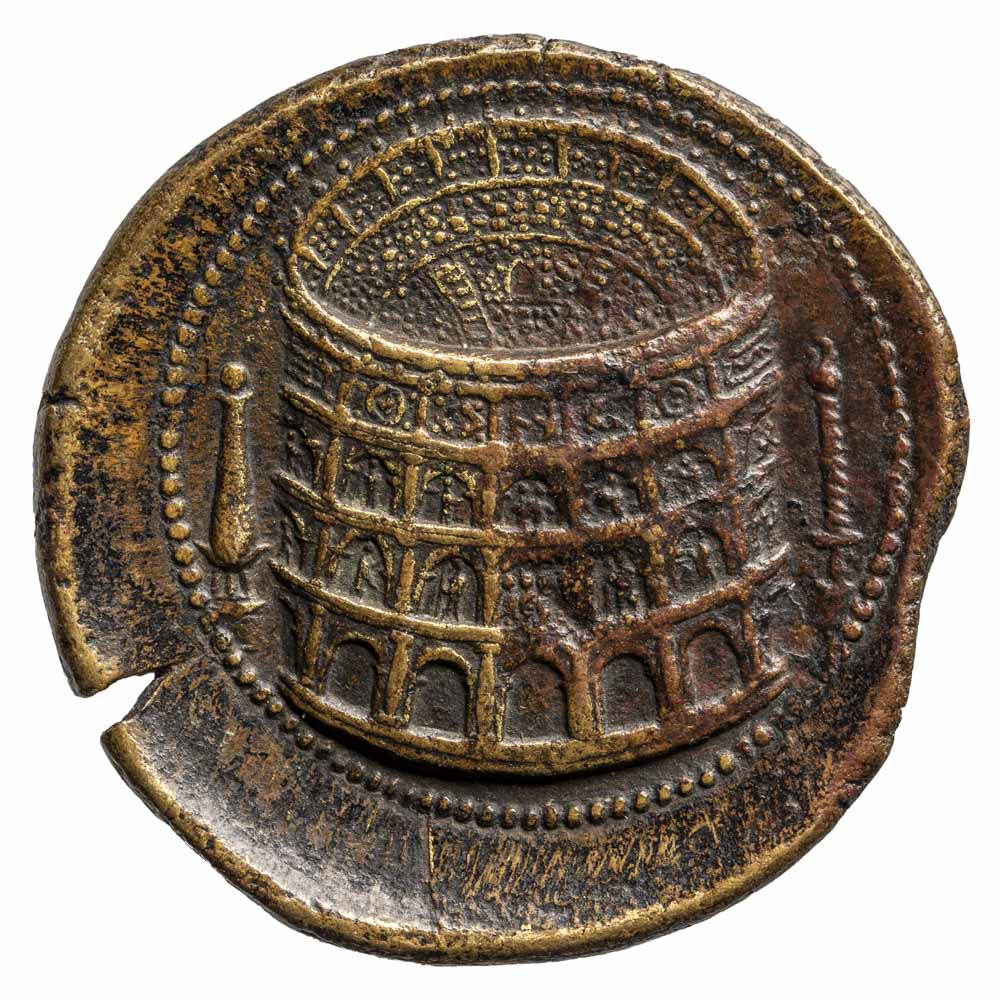
Cavino’s imitation of
Nero’s Porta-Ostiensis coin is also found in the ninth volume of
the MaNO (figs 29a and b)[53].
The fact that this coin was an imitation created by Cavino is
evident by the row of shields on the ship in the coin’s centre
(fig. 30) which can only be found on this imitation. In the
Diaskeué, Strada claimed to have this piece in his own
collection[54].
His contemporaries however reproduced the ancient original[55].
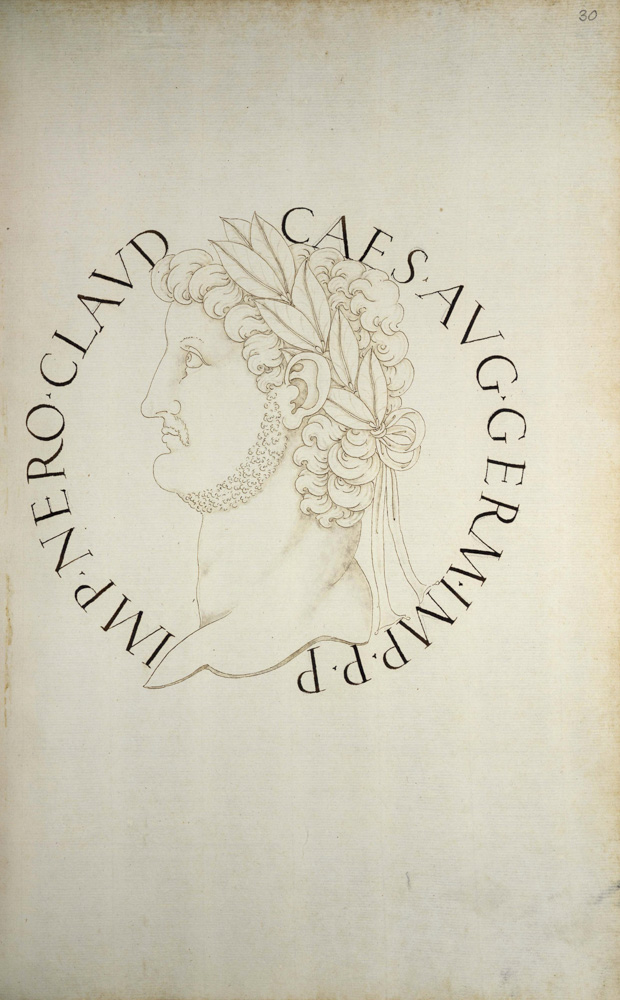
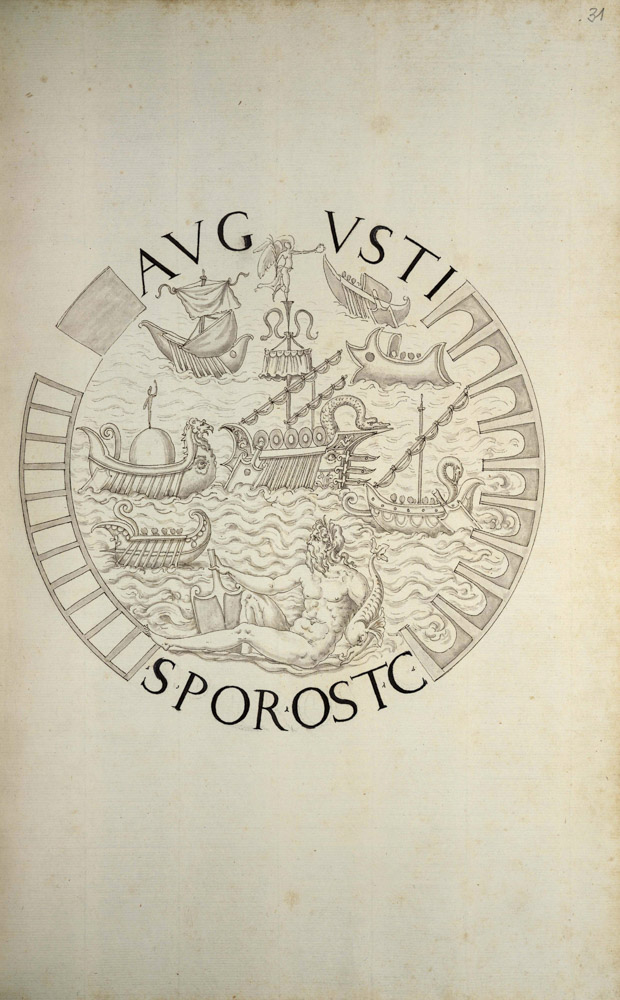
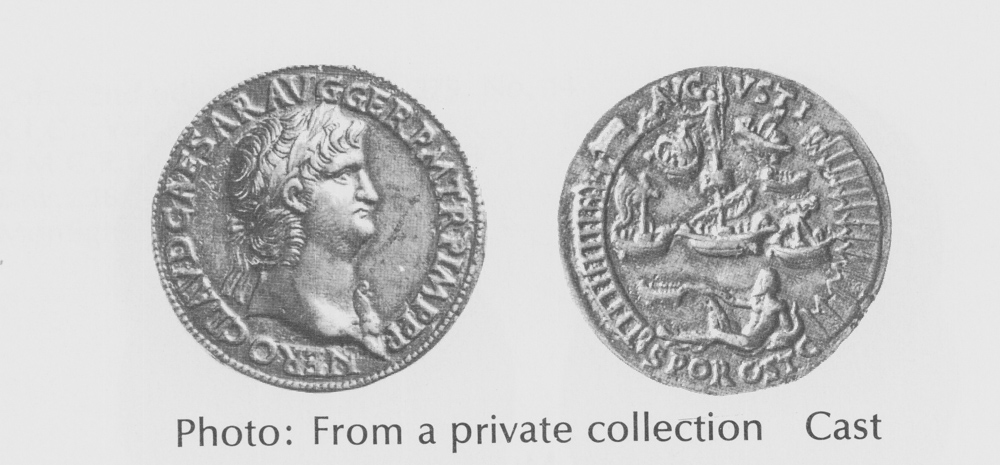
Another Paduan shows
»Augustus among the Gods« (figs 31a and b)[56].
Strada depicted Augustus with a shield in his left hand and a
sceptre in his right in addition to Terra with a sea monster and
Oceanus with a dragon-like monster as shown on the imitation by
Cavino (figs 32a and b)[57].
On the contorniate, dating to the fourth century AD
(figs
33a and b)[58],
which probably served as model, Augustus holds a globe in his
left hand and a spear in his right; Victoria holds a wreath in
her raised right hand; a bovine is placed behind Terra and next
to her appears a blossoming plant. A dolphin-like sea monster
stands before Oceanus with crab claws stuck in his hair, while a
water plant can be seen behind his back. Vico and Ligorio
(figs
34a and b) also depicted this Paduan, whereas Goltzius shows the
original (fig. 34c)[59].
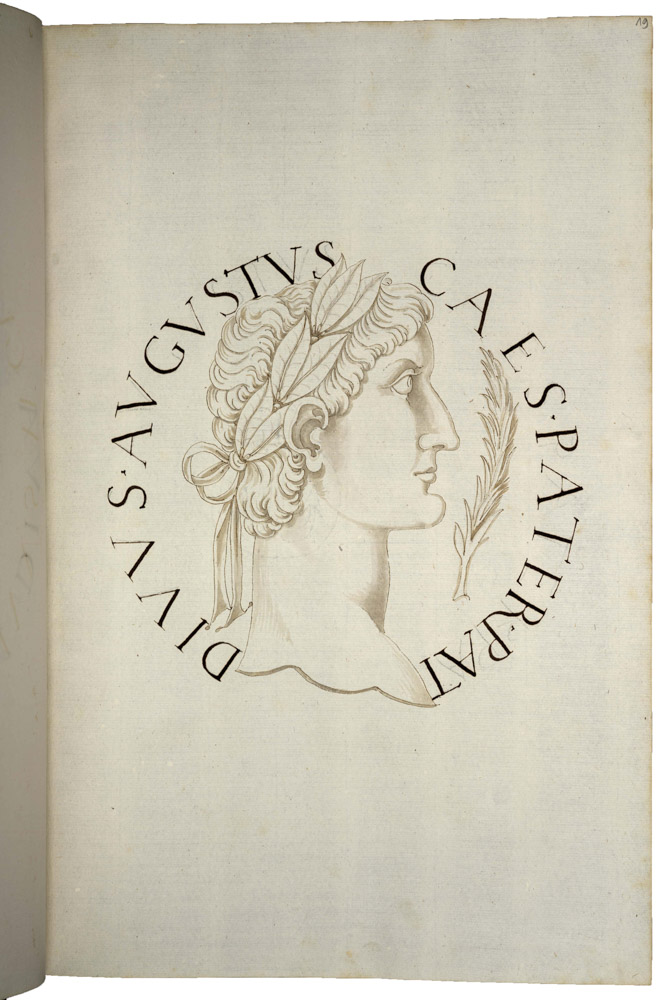
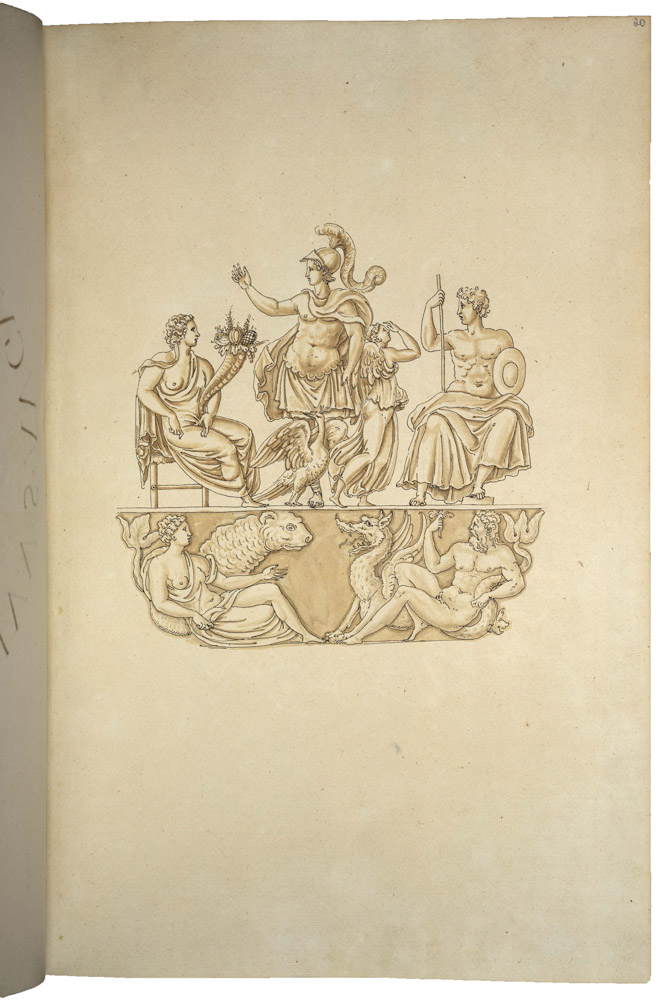
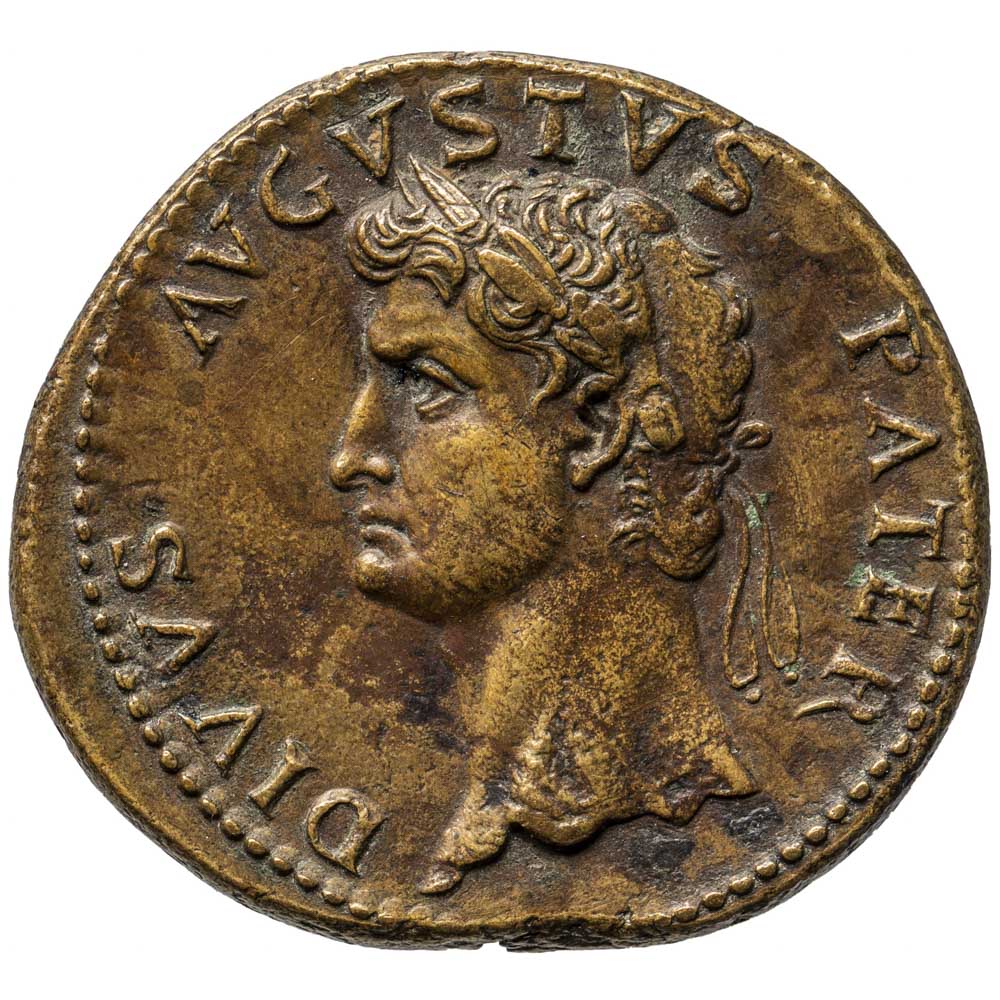
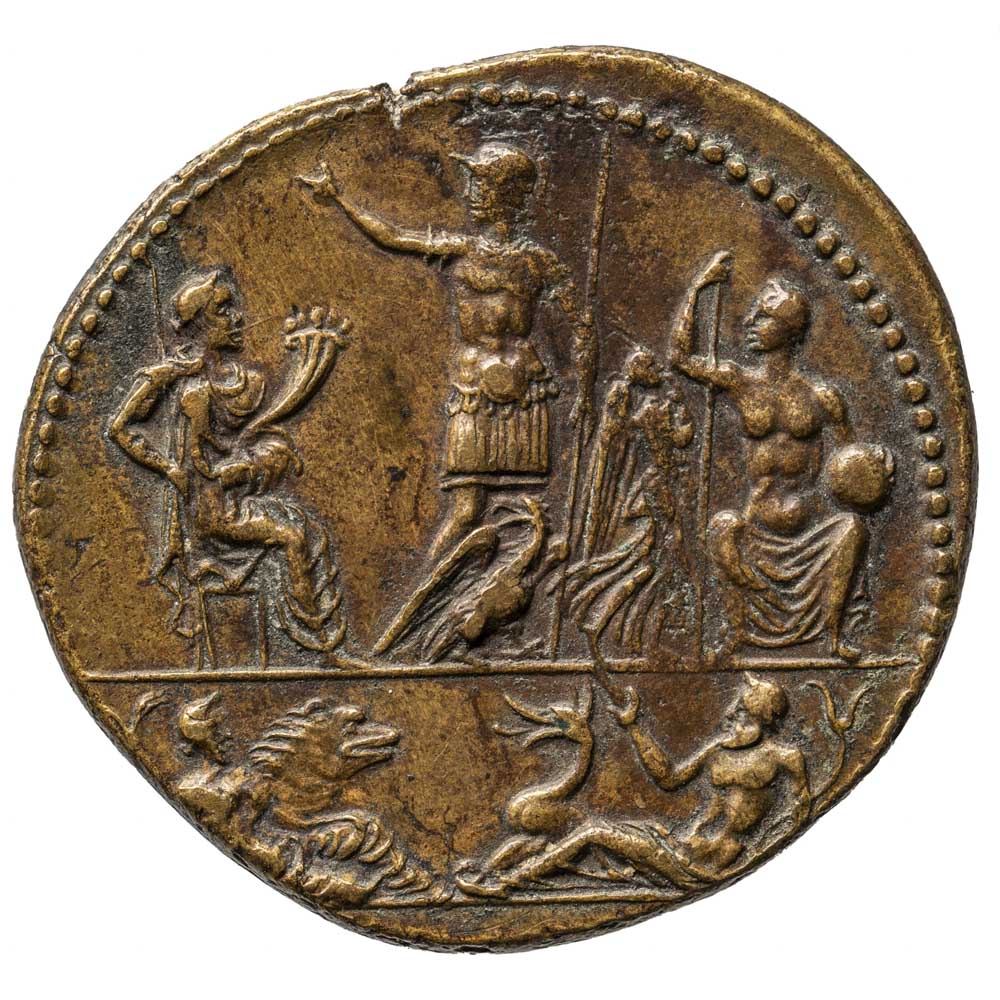
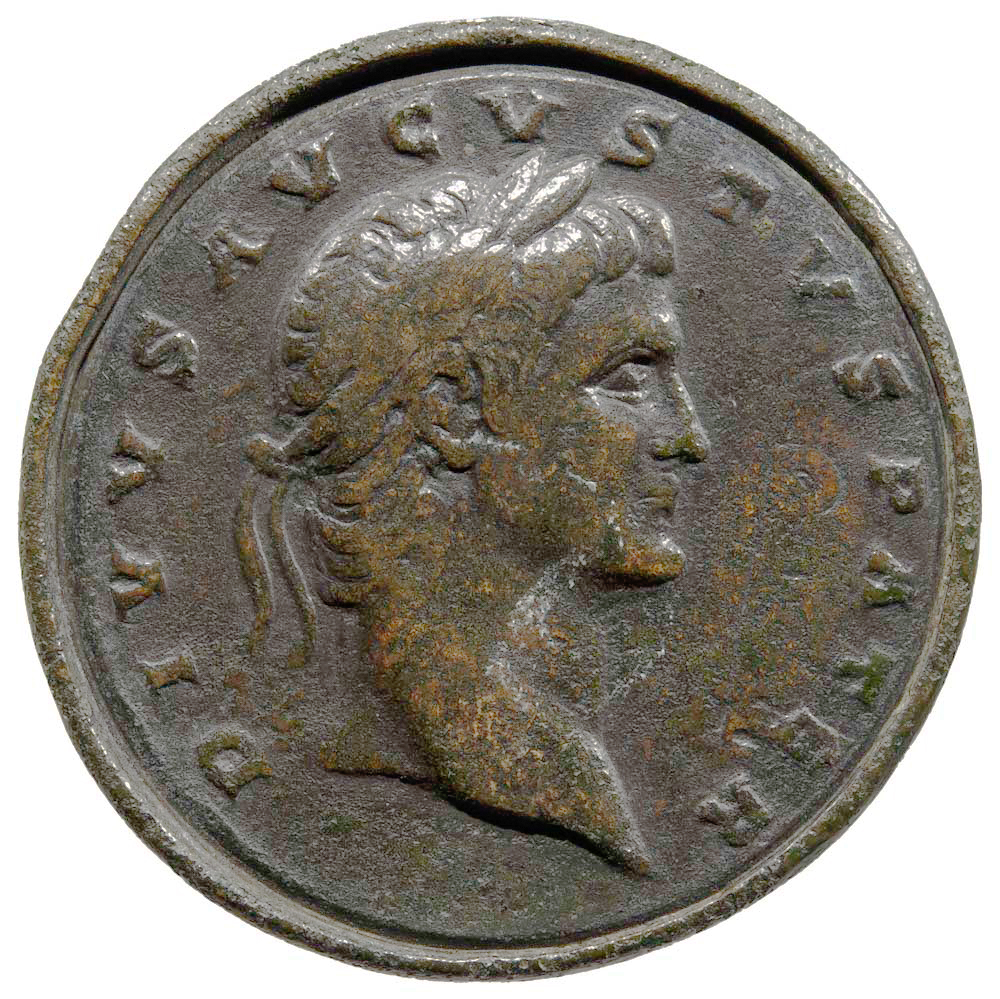
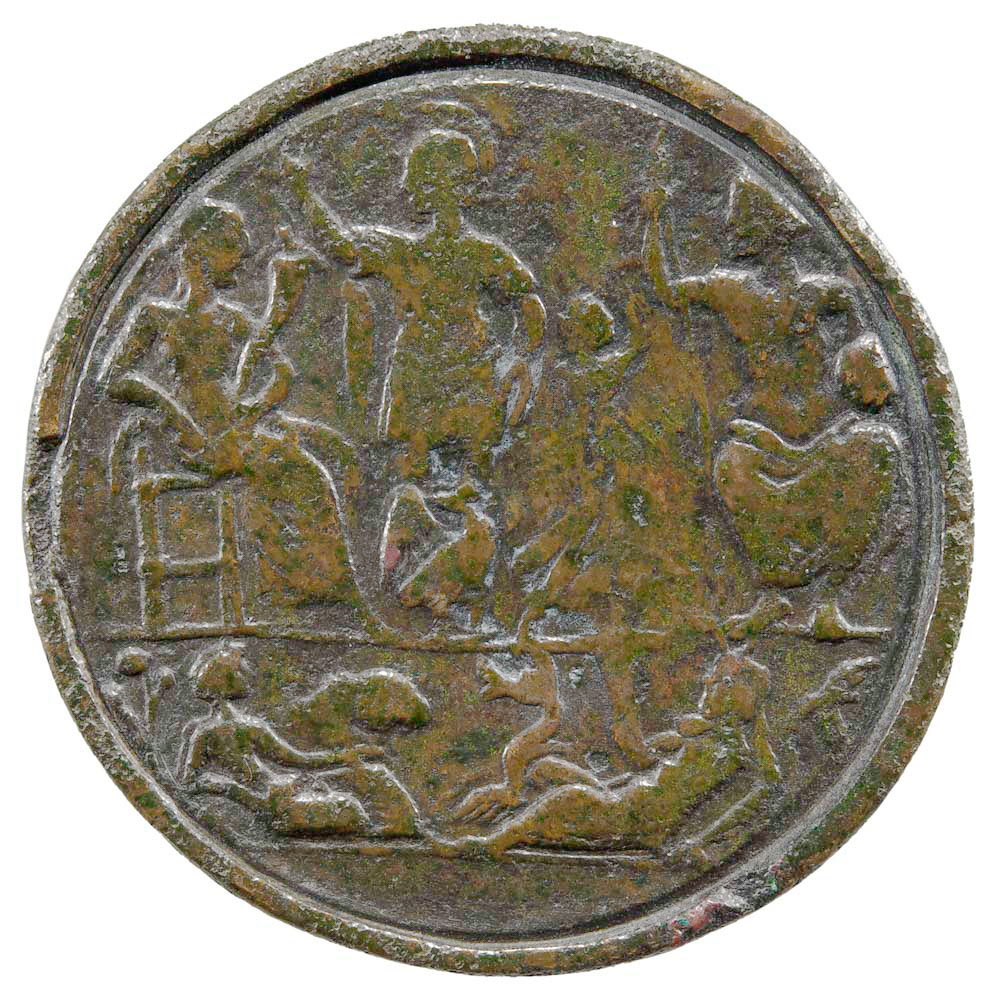
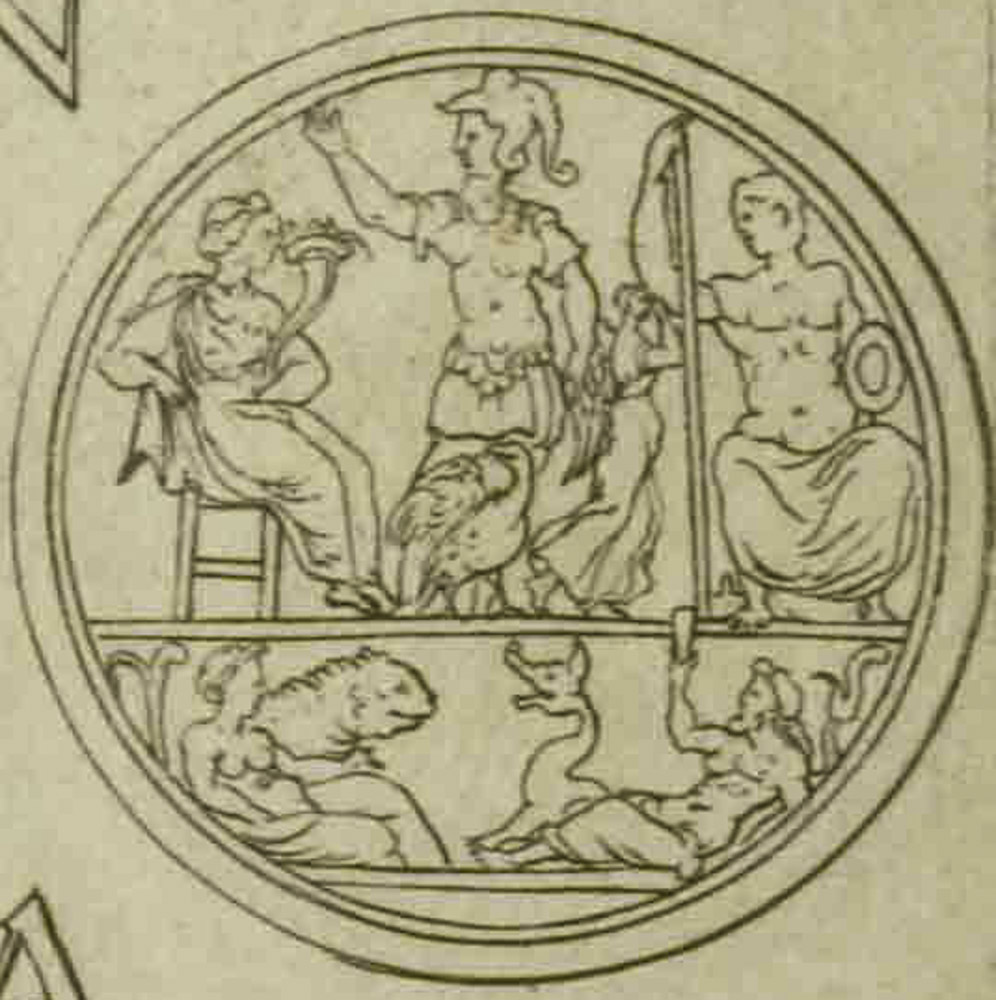
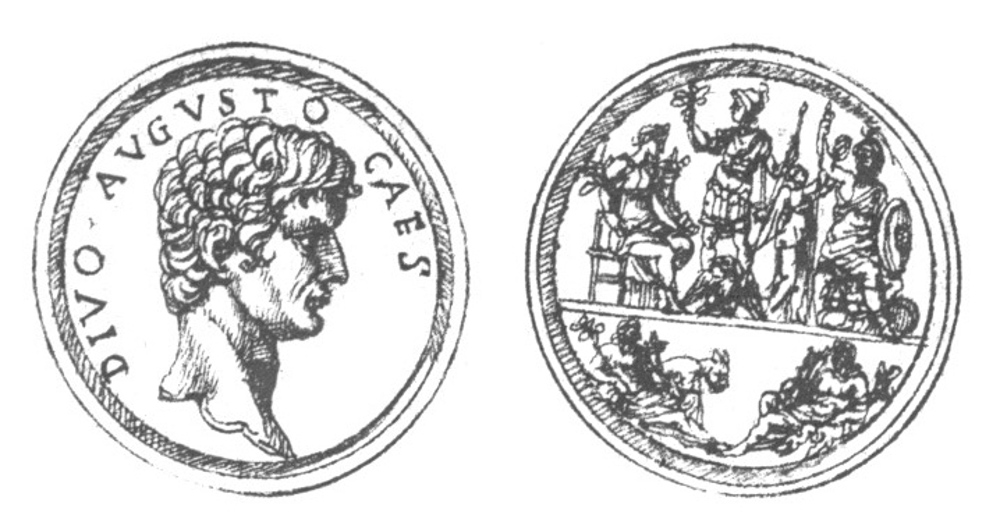
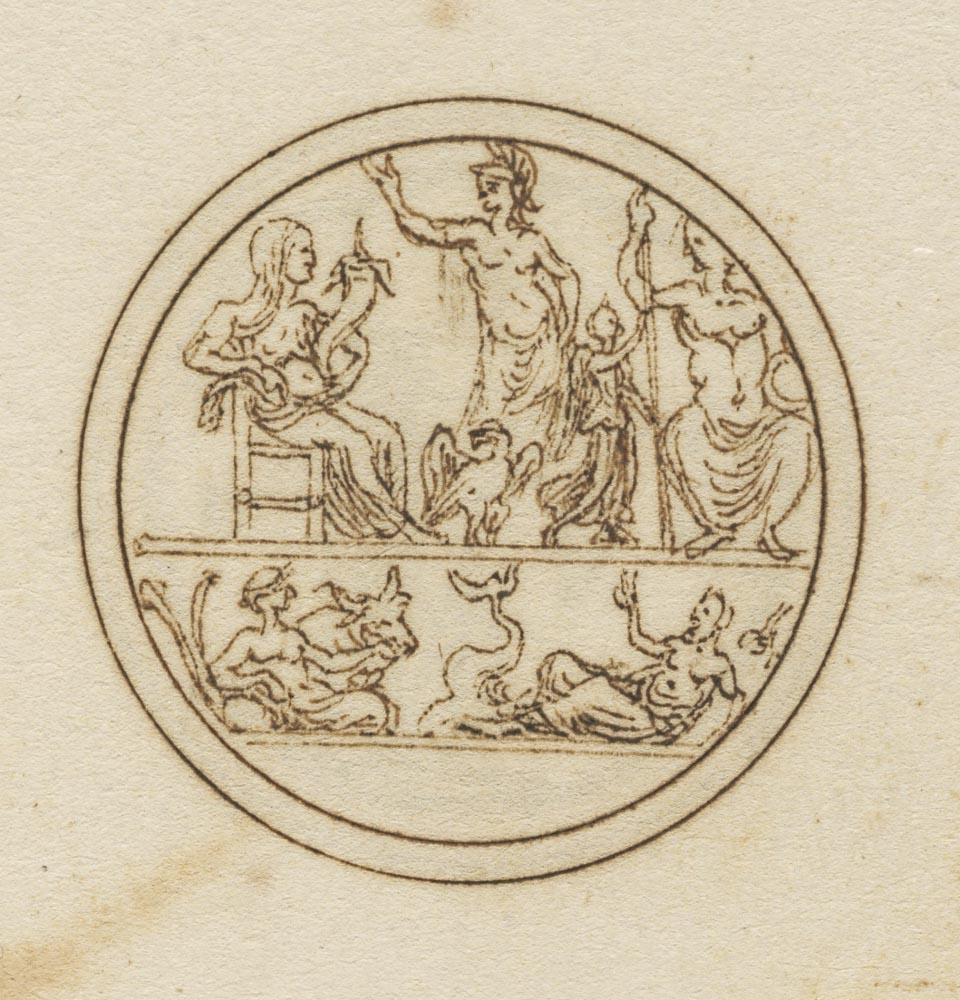
For the final piece to
be discussed here, Strada described the ancient originals in the
Diaskeué in detail, while presenting a new, previously
unknown version in the MaNO. The coin’s ancient original
shows ›Honos‹ (to the left) and ›Virtus‹ (to the right)
looking at each other (figs 35a, b and c). ›Honos‹ holds a
cornucopia in his left hand and a sceptre in his right; ›Virtus‹
wears a helmet and military attire, the parazonium is in her
right hand and a lance in her left. Her right foot rests on a
helmet and the legend reads: HONOS ET VIRTVS S C[60].
The coin image is described in the Diaskeue in the same
way[61].
Strada mentions Antonio Agustín as the owner, whose collection –
as mentioned above – was looted and dispersed by Napoleonic
troops in the early nineteenth century. In Agustín’s original
edition Dialogos de medallas inscriciones etc.,
this coin was depicted exactly as described by Strada, i.e.
identically to the ancient original[62].
Ligorio as well depicted it in this fashion[63].
On Cavino's imitation (fig. 35b)[64],
however, Honos places his right foot on a dolphin and Virtus her
right foot on a turtle. Vico also reproduced the coin in
accordance with the Paduan (fig. 35c)[65],
whereas Strada turned the dolphin into a helmet and the turtle
into a globe (fig. 36a)[66].
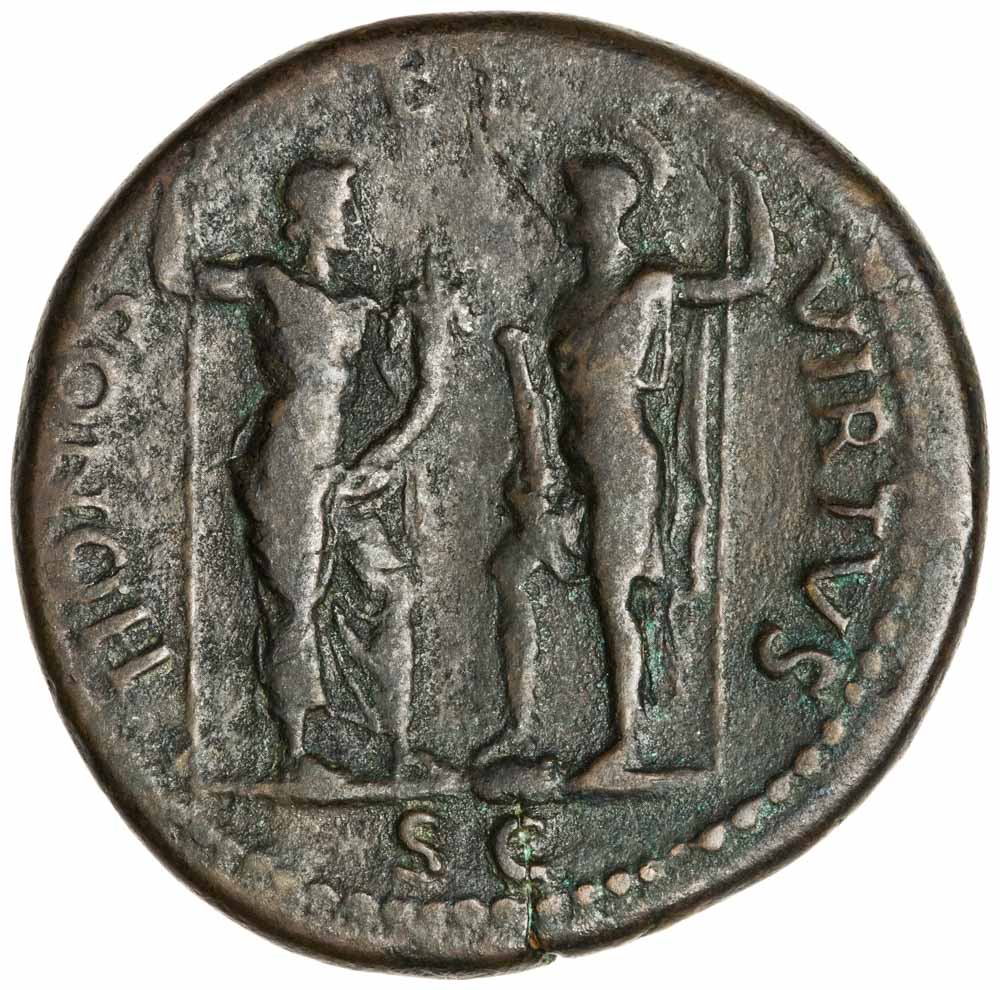
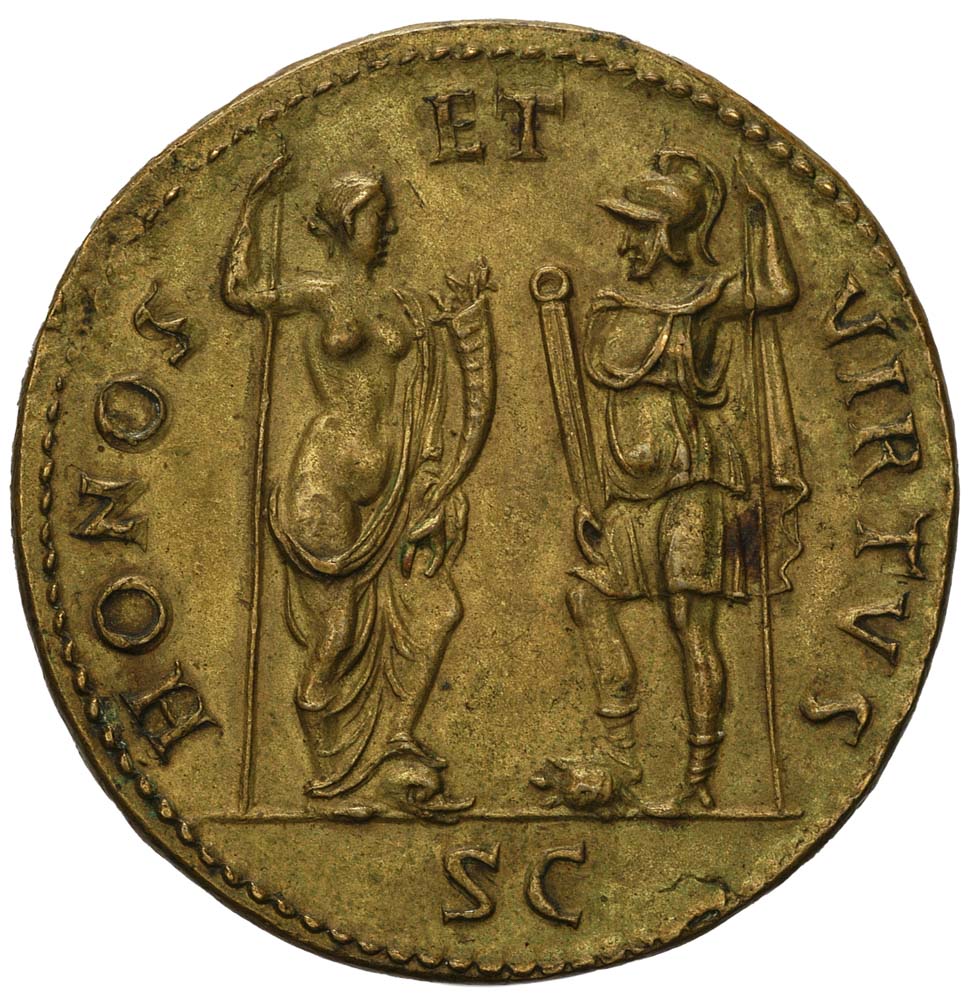
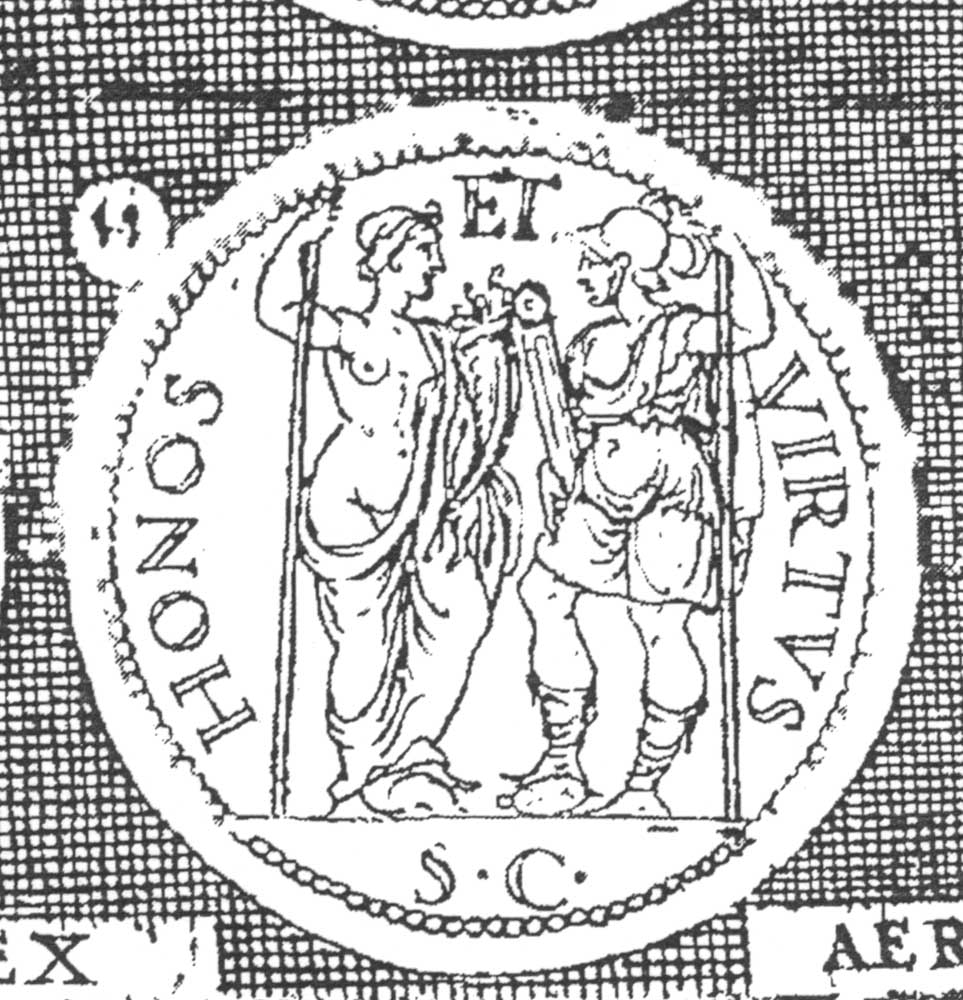
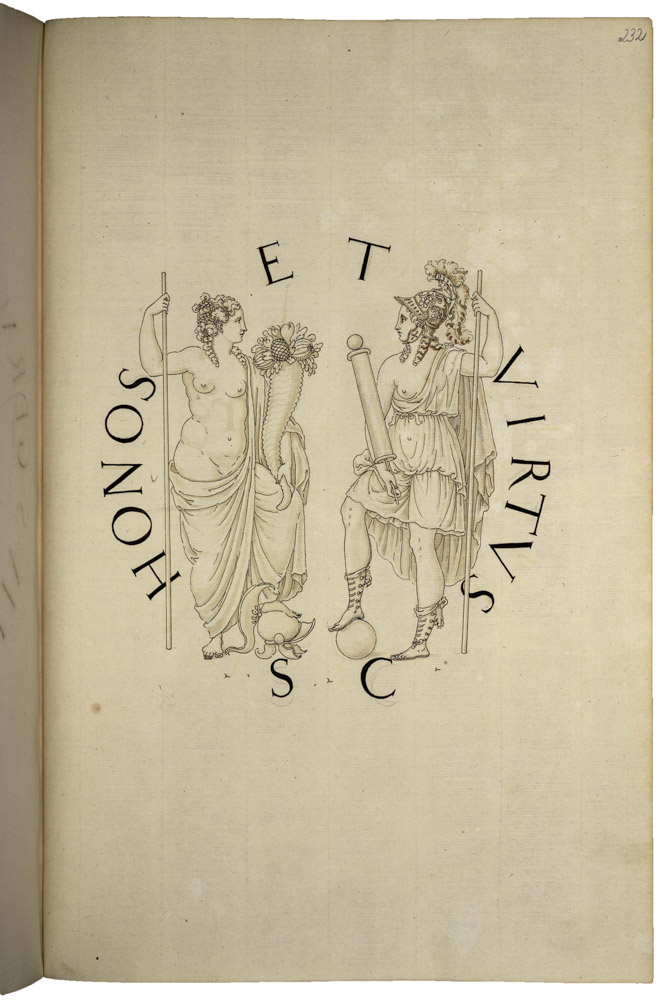
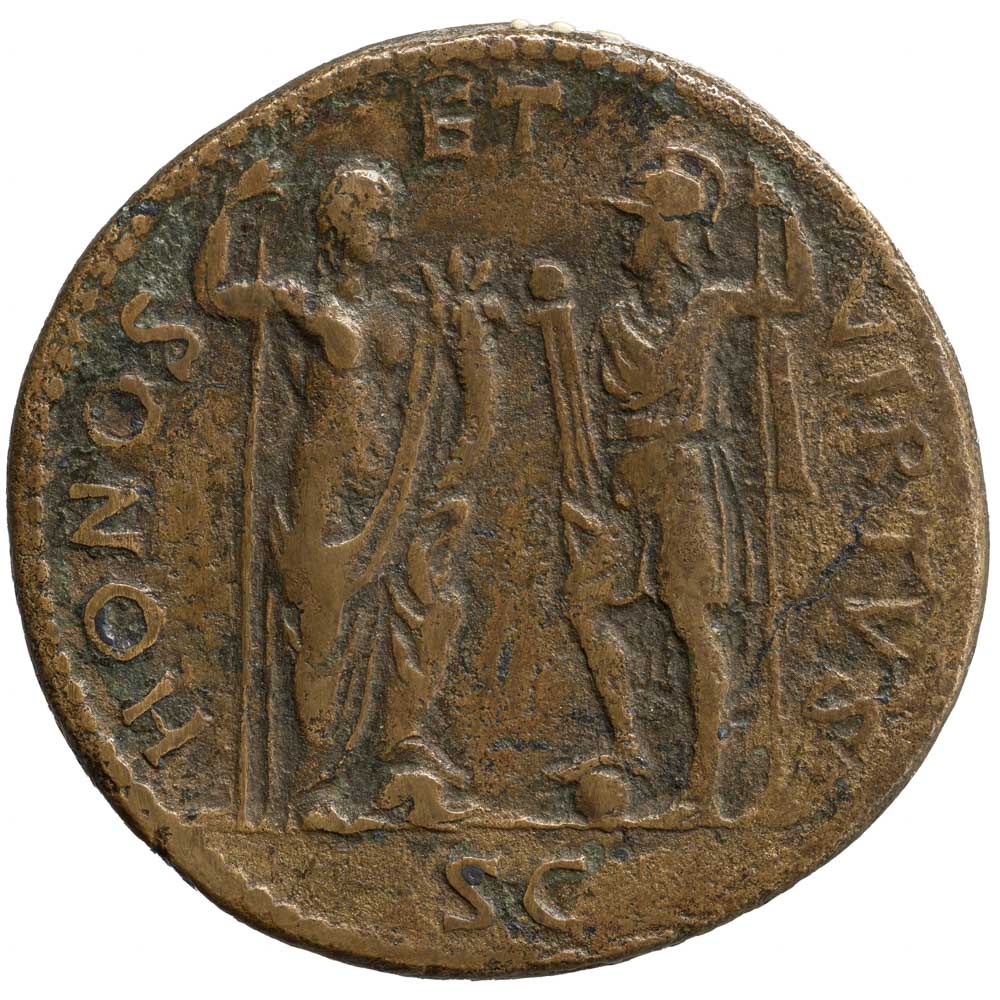
The model for Strada’s
depiction can be found today in the Vienna Coin Cabinet (fig.
36b). It originally came from the Tiepolo Collection.
Senator Giovanni Domenico Tiepolo had acquired Sebastiano
Erizzo’s famous coin collection at the end of the seventeenth
century; in 1821 it was sold to Emperor Francis I of Austria[67].
Thorough examination of this piece showed that it was much
reworked – possibly even a cast[68]
– and in all likelihood not an original[69].
Therefore, the drawing was certainly modelled on the piece from
Erizzo’s collection, with whom Strada was closely associated, as
numerous owners’ details in the Diaskeué attest[70].
Unfortunately though, this coin is neither described nor
illustrated in Erizzo’s work Discorso sopra le medaglie[71].
The obvious diversity
between the description and illustration of this piece ought to
be seen as evidence that the Diaskeué does not contain
coin descriptions that complement the illustrations in the
MaNO. Originally, this assumption
had provided the foundation of our project and was based on
Strada’s statement in his book catalogue[72]
and on his declaration in the
preface to his commentary on Caesar[73],
in which he explained that the coin descriptions in the
Diaskeué were meant to match the drawings after ancient
coins in the MaNO.
This short summary shows
that Strada – although he was aware of the problematic issue of
modern creations after the antique – was not always able to
distinguish between originals and imitations. To tell them apart
would have required – in addition to a thorough autopsy and
related methods of examining the material, presentation and
legends – the use of an accepted reference work or catalogue.
Unfortunately, at the time, no such work existed. Extensive
research and a proper methodology of comparison, for which none
of the prerequisites were yet available, would have been
necessary. Strada’s Diaskeué was a first attempt to
compose such a work. Interestingly, it did not meet with the
expected success, since the Diaskeué was never printed
and only survived in two complete manuscript copies[74].
Thus the work was only known to specialists, such as Adolfo Occo
(1524‒1606)[75],
as well as to the imperial librarian in Vienna, Peter Lambeck
(1628‒1680), or Charles Patin (1633‒1693) whom Lambeck guided
through the imperial library[76].
Therefore, Strada never received the full ›scholarly‹
recognition for his work by his fellow antiquarians.
In addition, there was a
desire for completeness which was not only characteristic of
Strada, but also of the other so-called artists-antiquarians,
such as Enea Vico, Pirro Ligorio and Hubertus Goltzius, who were
led by this ambition to create reconstructions or imitations
(inventions/fantasies)[77].
Consequently, Strada stated the following reasons for this type
of invention in the preface to the first volume of the
SERIES Impp. Roman. ac Graecorum et
Germanorum omnium a.C. Iulio.C.F.C.N. Caesare usque ad
Maximilianvm II. Caes. P. F. Aug. una cum liberis patrimis atque
matrimis ex a.a.a. numismatibus quam fidelissime delineatis:
inservimus etiam iuxta tempora hexarchos et longobardor reges
omnusqve cum ipsorum elogiis breviter descripsimus. Tomus primus
continet XII Caes. a C.IVl.C.F.C.N. Caes. usq. ad Nervam Imp.
Ex Musaeo. Iacobi de Stradae Mantuani
Caess. Antiquarii Civis Romani[78]
– meant as a short synthesis of
the MaNO and the Diaskeué and intended as a gift
for rich patrons, in particular the emperor: »Nevertheless, in
any case it is true that not all coins match all inscriptions,
as I would prefer: the reason is that not all of them were
discovered, although all of them were minted«[79].
Due to their knowledge of the material and iconography, these
artists-antiquarians, i.e. the engravers Cavino, Cellini etc.,
were also able to create »inventions after the antique«. This
kind of creativity contradicted the intention of the so-called
›humanist antiquarians‹, such as Antonio Agustin and Jean Matal,
who wanted to explore antiquity in all its aspects entirely on
the secure basis of authentic ancient monuments and literary
sources[80].
Therefore, Agustín was suspicious of inventions by
artist-antiquarians, as he expressed in the well-known statement
in his work Dialoghi intorno alle medaglie, iscrittioni et
altri antichità:
My friend Pirro Ligorio
from Naples, a great antiquarian and painter, wrote over forty
books [i.e. manuscripts] about coins, buildings and other things
[...] without really mastering Latin, as did Hubertus Goltzius,
Enea Vico, Jacopo Strada and others. Those who read their books
might think that they read all the Latin and Greek books ever
written. They took what they needed from others and they exactly
drew with the pen what others described […][81].
The artist-antiquarians
wanted to reconstruct the ancient world as it had been using
their imagination and coin images. This development would come
to its peak in 1561 with Pirro Ligorio’s great plan of Rome
(figs 37a and b) Anteiquae urbis imago accuratissime ex
veteribus monumenteis formata, the buildings in which are
exclusively based on coin images[82].
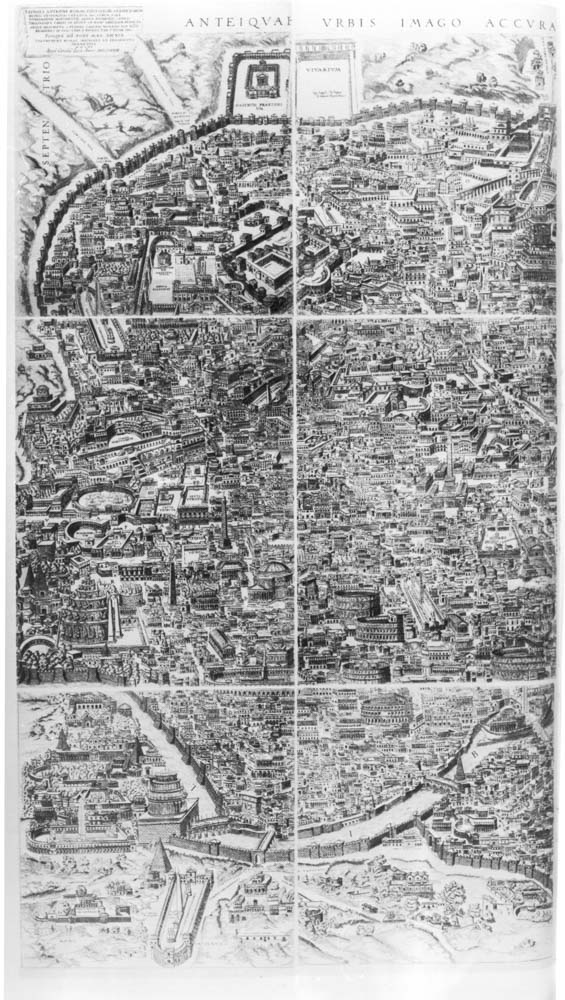
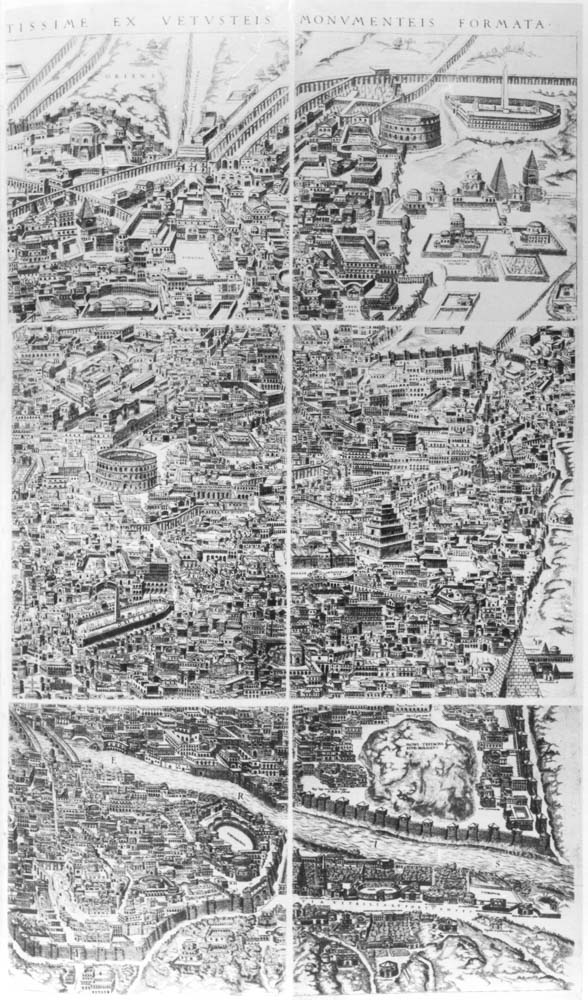
Paduans and other
all’antica medals remained extremely popular well into the
eighteenth century. Until the end of the Ancien Régime, these
coins presented outstanding objects for the knowledge,
appropriation and moral-educative role they possessed, even
though or precisely since they had no ancient origins. Although
they began to be criticized as copies by scholars by the end of
the sixteenth century, they would not be rejected as forgeries
until the nineteenth century[83].
Translation: Andrea M.
Gáldy:
agaldy@hotmail.com
* My contribution was originally to
be presented under the same title on 2 April 2020 at the
annual meeting of the Renaissance Society of America in
Philadelphia as part of the session »Renaissance
Numismatics, Medals and Exonumia« which had to be
cancelled due to the corona crisis.
[1] On
Strada’s date of birth, see Heenes 2010, pp. 296‒297,
note 4. Most recently and comprehensively, Jansen 2019,
p. 48 on Strada’s life and work.
[2] Jansen 2014, pp.
155–172; Jansen 2019, pp. 57–60.
[3] Weskie –
Frosien-Leinz 1987, p. 35 with note 53.
[4]
Jansen 2019, pp. 60‒61.
[5]
Translation: Excerpt from the treasure of antiquities,
i.e. the images of Roman emperors, eastern and western,
drawn as faithfully as possible from ancient coins. From
the museum of Jacopo da Strada, Mantuan Antiquarian.
[6]
Strada used the woodcuts of the emperors and their
relatives once more in the Fasti et triumphi;
Dekesel 1993, p. 33.
[7] Heenes 2003, p.
21; Peter 2016, p. 167.
[8] Lemburg-Ruppelt
2000, p. 115.
[9]
Ibid.; e.g. Epitome, pp.
13‒14:
temple of Janus Quadrifrons from
MaNO
4, fol. 237r;
p.
18: The
mausoleum of Augustus from
MaNO
5, fol 213r,
or pp.
62–63:
the Palatium Nervae from
MaNO
14, fol. 24r. However, no
genuine coins can be linked to the drawings mentioned.
[10]
Translation: Important and new work, containing
the description of the life, the images and of all coins
of both the Western and Eastern emperors and of the
tyrants (usurpers), with their co-regents, wives and
children, up to Emperor Charles V. Elaborated by Jacobo
de Strada from Mantua. First volume, 1550.
[12] E.g.
Epitome, p.
27: an
aureus of Claudius with the Aqua Claudia (really
the praetorian camp),
RIC I2 Claudius 7;
p.
56: a
sesterce of Titus with the Colosseum,
RIC II,12 Titus 185;
p.66:
a sesterce of Trajan with the Circus Maximus,
RIC II,2 Trajan 571/MIR
175a; pp.
102–103:
Ritus Ludorum Secularum Templum duobus colonis
insistens,
RIC IV Geta 132;
p.
111: a
contorniate of Elagabalus with
the Temple of Sol Invictus,
Gnecchi 1912, vol. 3 p. 40 no. 6; p.
114: a
denarius of Alexander Severus with the restored
Colosseum,
RIC IV Alexander Severus 33;
p.
129: a
contorniate of Philippus Arabus with an amphitheatre
(Colosseum), Gnecchi 1912, vol. 2 p. 99, no. 12; p.
134: a
sesterce of Vibius Trebonianus Gallus with the Temple of
Juno Martialis,
RIC IV Trebonianus Gallus 54.
[13] Lemburg-Ruppelt
2000, p. 115.
[14] Heenes 2003, p.
21. On Varro’s system, see
Momigliano 1950, p. 289.
[15] On
the difference between the terms ›imitations‹ and
›fantasies‹, see de Callataÿ 2014, pp. 269–291.
[18]
Missere 2013, p. 280.
[19] Out
of 3,764 drawings from the first 14 MaNO volumes,
examined up to now, about two thirds could be matched
with ancient models. About 18 Paduans have so far been
identified.
[20]
MaNO
2, fols 3r‒4r.
[21]
Translation: Description of ancient gold, silver and
bronze coins, i.e. explanation of the coin images of the
Chaldeans, Arabs, Libyans, Greeks, Etruscans and
Macedonians, Asians, Syrians, Egyptians, Sicilians,
Latin and Roman kings from the foundation of the city,
of the gods, the consuls at the time of the Roman
Republic until today, both among the Latin emperors in
the West and among the Greek emperors in the East and
finally, when the empire of the Roman people perished,
of the exarchs and of the princes and dukes of the
barbarians. From the museum of the Mantuan antiquarian
Jacopo Strada, Roman citizen. With seven very reliable
indices, partly alphabetical, which contain the most
diverse things, partly chronological, which describe the
names of the kings, caesars, emperors and tyrants and
also of heroes.
[22]
On the description of the reverse,
see Diaskeué 2, fol. 123v, p. 72 no. 3.
[24] Here
and on the following, see Lemburg-Ruppelt 2000, p. 117
with note 13.
[25] Livy,
Ab urbe condita liber CXX periocha.
[27]
Information by Massimo Bulgarelli, Venice.
[28]
Information by Ingo Herklotz, Marburg, and Arnold
Nesselrath, Rome.
[29]
Information by Ingo Herklotz, Marburg; Cichorius-scenes
XXIII und LXXI.
[30] ÖNB
shelfmark Cod. 9410; Jansen 2019, pp. 684‒685; p. 860.
[31]
Information by Arnold Nesselrath, Rome, and Timo
Strauch, Census, Berlin.
[32]
MaNO 3, fols 178r–179r.
[33] Information by
Karsten Dahmen, Münzkabinett SMB, Berlin, and Michael
Matzke, HMB, Basel.
[34]
Plutarch, Antonius 68,1.
[35]
Discours, p. 20; RIC II Hadrian 62 (=
RIC II,32 Hadrian 509-510);
RIC II Hadrian 662 (RIC
II,32 Hadrian 748).
[36]
MaNO
9, fol. 145r. (CensusID
10183804,
RIC Nero 323)
[37]
Information by Michael Matzke, HMB, Basel.
[38] The
previous
folio 236r in MaNO vol. 4
depicts the uncrowned Augustus accompanied by a divus
legend.
[39]
Discours, p. 21.
[40] Ohm
2014, pp. 81‒83; Ohm 2015, p. 221; Darnis 2003, pp.
15‒17; Stahl 2015, pp. 266‒287.
[41]
Zeitz – Zeitz 2003, p. 140 no. 63.
[42]
Zeitz – Zeitz 2003, p. 187 no. 98.
[43]
MaNO 1, fols 233r‒234r.
[44]
Diaskeué
2, fol. 88r, p. 1 Nr. 2;
not illustrated in the Dialogos.
[45]
Agustín bequeathed his coin collection to the Spanish
king. It included 130 gold coins, 1400 coins in silver
and 3871 in bronze. The bronze coins were taken to the
coin cabinet at the monastery San Lorenzo de El
Escorial. They were stolen by Napoleon’s troops; their
present location is unknown. In the original edition (Dialogos)
only 292 coins are depicted on 52 pls. These coins
probably came from Agustín’s collection (information
provided by Paloma Otero, Museo Arqueológico Nacional,
Madrid and Mariano Carbonell, Universitat Autònoma de
Barcelona).
[46]
Klawans 1977, p. 21 no. 5: Obverse: Caesar laureate
l.r., DIVI IVLI; Reverse: Caesar riding the elephant
quadriga, LS SC. Most recently: Asolati 2018, pp.
138–139. A potential model for Cavino could have been an
Egyptian bronze coin of Trajan (RPC
III, 4667, 2). Information
provided by U. Peter, BBAW, Berlin.
[48]
Klawans 1977, p. 68 no. 7.
[50]
Diaskeué 3, fol. 118r no. 4 (CensusID
10193997)
with MaNO 11, fol. 128r–129r
(CensusID
10193992
and
10193995);
Klawans 1977, p. 64 no. 6, Colosseum with Meta Sudans.
[51] RIC
II,12 Vespasian 194 (CensusID
10051539);
RIC II,12 Domitian 131 (CensusID
10066886).
Matzke 2018, pp. 144‒145; p. 149.
[52] See
Matzke 2018, p. 148 no. I.51. Whether the left-facing
Vespasian and the legend COS VIII is an independent
type, so far unknown to scholars, or whether Strada made
mistakes here, must remain open.
[53]
MaNO 9, fol. 30r and fol. 31r; RIC I2
Nero 179; Klawans 1977, p. 44 no. 2 (CensusID
10183794
and
10183797).
[57]
Klawans 1977, p. 24 no. 5.
[58]
Alföldi 1976, p. 225.
[60] RIC
II,12 Vitellius 113.
[62] The
sesterce of Vitellus with Honos and Virtus illustrated
therein (Dialogos, p.
94; RIC
I2 Vitellius 113, CensusID
10187200)
matches Strada’s description in der Diaskeué, as
well as the illustration in the Italian edition of 1592
(Discorsi, pl.
9). In
the second Italian edition of 1592 (Dialoghi, p.
81) the
illustrations are embedded in the text and the
illustration matches Cavino’s copy.
[63] AST
21, p. 183, fol. 134v.
[64]
Klawans 1977, p. 58, no. 1; Matzke 2018, p. 143 no.
I.47.
[66]
MaNO 10, fol. 232r (CensusID
10187213).
I would like to thank Jonathan Kagan, New York, for
bringing this discrepancy to my attention.
[67] Asolati
– Cattaneo 2019, pp. 133‒134 no. 69 (Marco Callegari).
[68]
Information by Michael Matzke, HMB, Basel.
[69] Information by
Klaus Vondrovec, KHM, Wien.
[70] See,
for example, Diaskeué 2, fol. 166v, p. 159, no.
108; fol. 182v, p. 192, no. 17; Diaskeué 3, fol.
220r, p. 626, no. 5; fol. 220v, p. 627, no. 7;
Diaskeué 4, fol. 77v, p. 792, no. 6;
fol. 105r, p. 847, no. 11.
[71]
Discorso; the coin is not even included in the later
editions of 1568, 1571 and 1585-1590.
[72]
Index sive catalogus librorum; ÖNB Cod. 10101 fol.
1v: Alius liber de omnis generis ethnicis et antiquis
numismatibus aureis, argenteis et aereis, quae passim in
universo mundo inveniuntur, et ego magnis impensis et
cura acquisivi, quae latine in XI voluminibus descripta
sunt. Et hac numismata partim ipsemet et apud me habeo,
sicuti fabrefacta et excusa sunt; partim ipsemet manu
mea delineavi ex ipsis numismatibus veris passim
estantibus apud antiquitatum studiosos et viros
primarios. Suntque eorum quae descripta sunt novies
mille; et inter haec multa peregrina, utpote latina,
graeca, hetrusca, arabica et aphricana variis
characteribus et literis insignita, prius apud nos non
visa et conspecta.
[73]
C. Iulii Caesaris,
Dedicatoria: Missus sum ab hinc annis
20. in Italiam, Romam, Venetias ac alio ad numismata
auro, argento, ac aere efformata, vetustateque insignia
marmora comparanda, quae ego magna vi pecuniarum expensa
Augustam, nobilissimis spolijs exuta Italia, advexi.
Sunt inter ea quam plurima Imperatorum ac Imperatricum
capita, multae insuper integrae marmoreae statuea,
aliaque opera non minimi precij & pervetusta. Haec omnia
quoque familiae Bavariae cesserunt. Verum nec illud
silentio involuere possum, apud eundem Fuccarum
absoluisse me mea ipsius manu 18. magna volumina
numismatibus referta studiose delineatis ex archetypis
suis aureis, argenteis ac aereis, in quorum sunt & ea
numero quaecunque ego numismata uspiam terrarum totos
hos annos 30. quos in hoc studium absumpsi, videre
potui. Additae sunt autem singulis descriptiones Latinae
non suppressis etaim dominorum suorum, apud quos mihi ea
videre contigit, nominibus. Haec omnia coniecta in 11.
magna volumina cum alijs meis maximis ac dictu
incredibilibus laboribus Fuggerus suae Bibliothecae
addiderat.
[74]
University Library Vienna, shelf
marks Ms III, 483 and
Hs III 160898/1-11;
Czech National Library Prague, shelfmarks Codd
1197–1207.
[75]
The structure of Adolfo Occo’s work Imperatorum
Romanorum is strongly reminiscent of the systematic
subdivision adopted by Strada in the Diaskeué;
information provided by Jonathan Kagan (New
York). For this work, see the PhD thesis of Gruber 2006,
pp. 5‒7.
[76]
Jansen 2019, pp. 10–13.
[77]
Further details: Missere 2013, pp. 279–281.
[78]
Translation: Series of all emperors of the Romans,
Greeks and Germans from Gaius Julius Caesar, son of
Gaius and grandson of Gaius, up to Maximilian II,
Caesar, the pious and happy Augustus, together with the
children, whose father and mother are still alive, from
bronze, silver and gold coins: We have also classified
all the exarchs and kings of the Lombards in accordance
with the times. We have briefly described these together
with their own inscriptions. The first volume contains
the twelve Caesars from Gaius Julius, son of Gaius and
grandson of Gaius, to Emperor Nerva. From the museum of
the Mantuan Jacopo Strada, antiquarian of the emperor
and Roman citizen (CensusID
10082563).
[80] See
the detailed discussion in Heuser 2003, pp. 88‒103.
[81]
Dialoghi p. 117.
[82] Most
recently: Long 2018, pp. 137‒138.
[83]
Burkart 2018, p. 25.
In his
letter of 29 January 1695
to Nicolas Thoinard (1629–1706), Andreas Morell
(1646–1703) criticized Strada’s imitations. The invented
coin of Vespasian, mentioned in the letter, is included
in MaNO 11, fols
22r–23r.
Information provided by F. de Callataÿ, KBR, Brussels.